
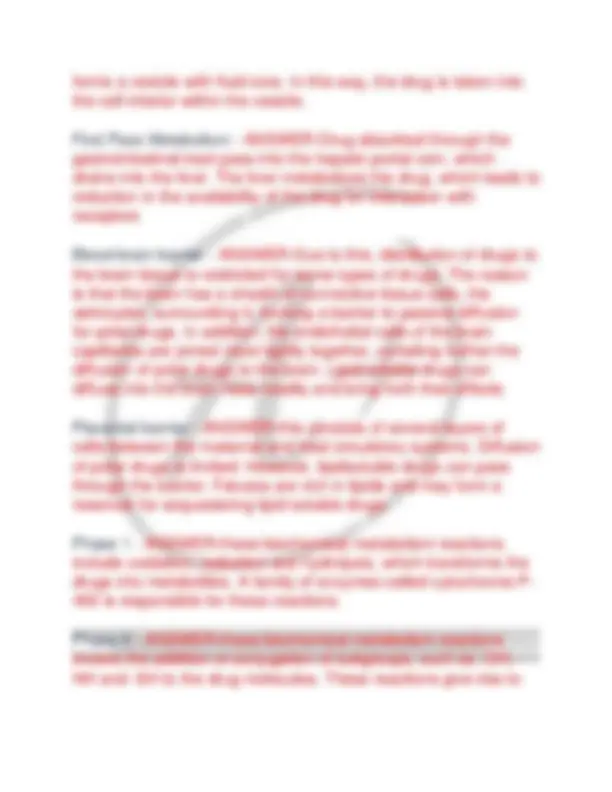
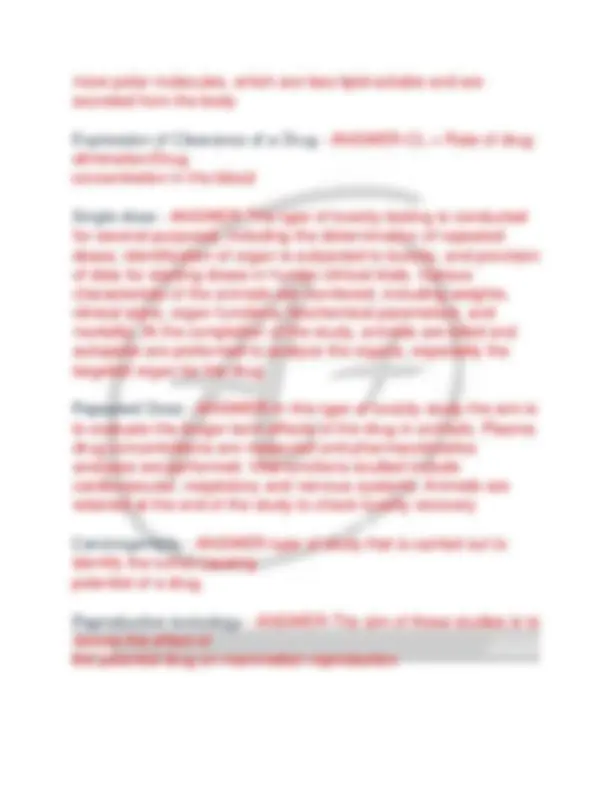

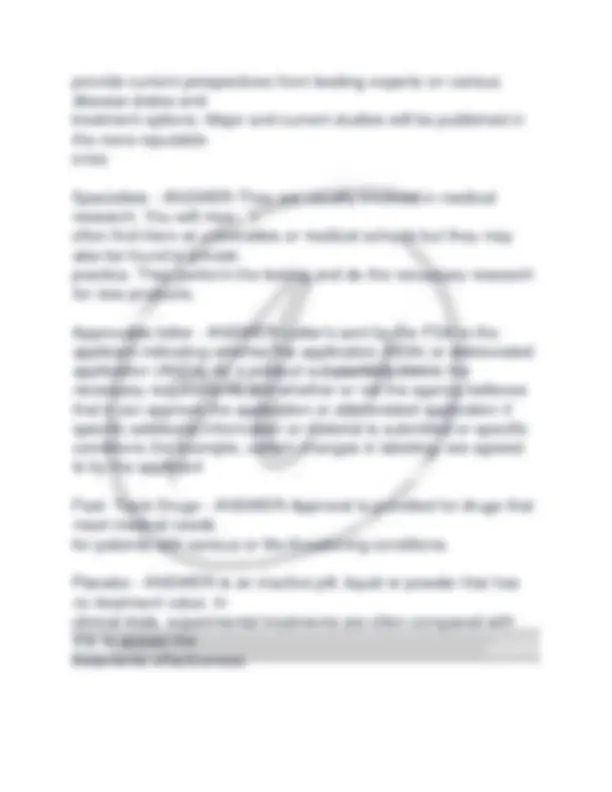

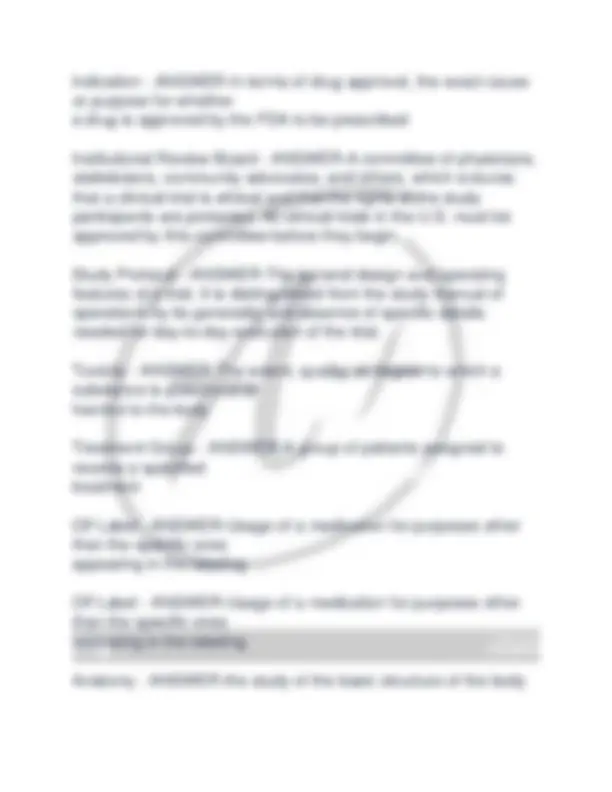
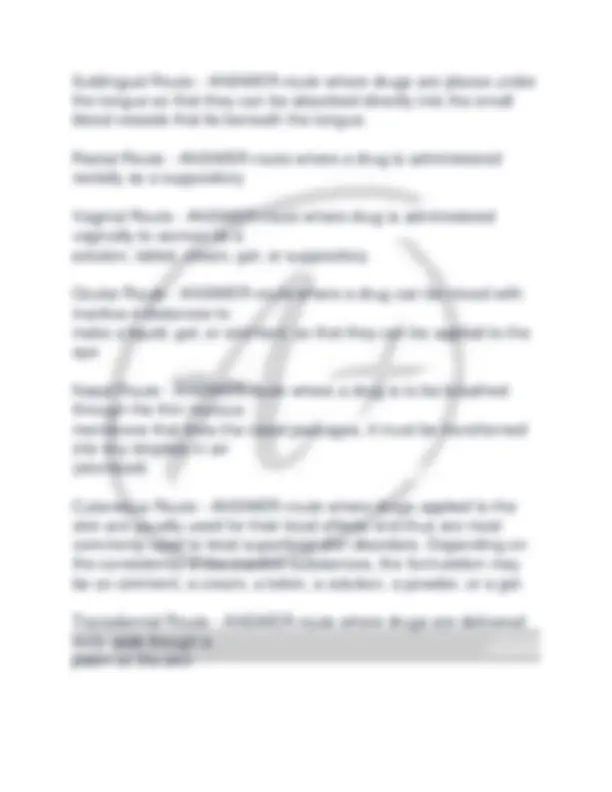
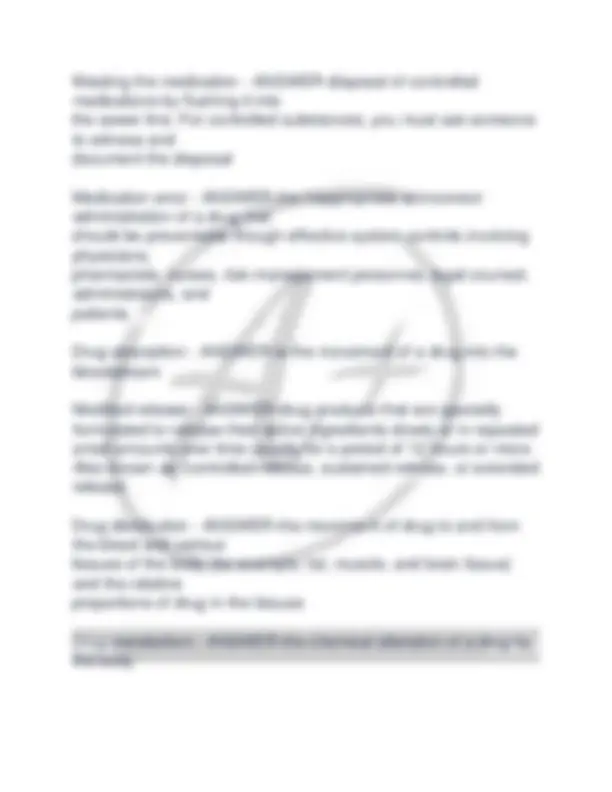

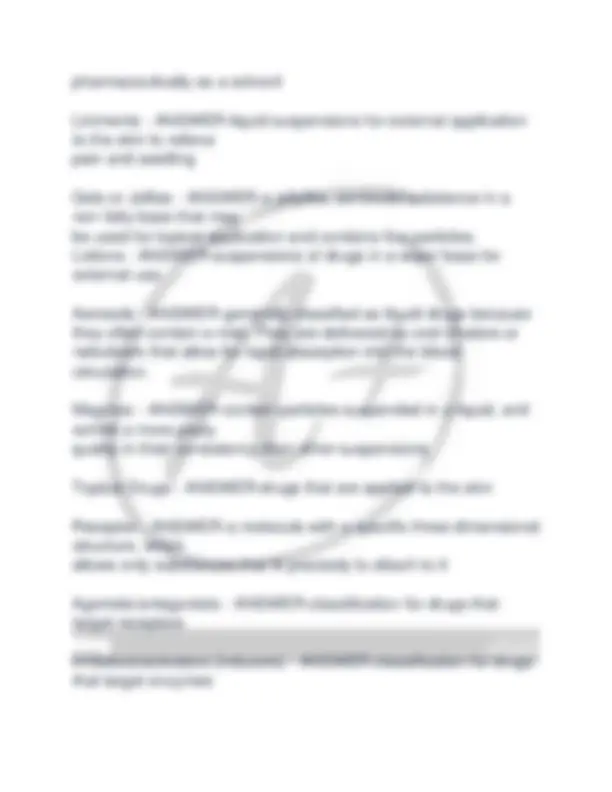
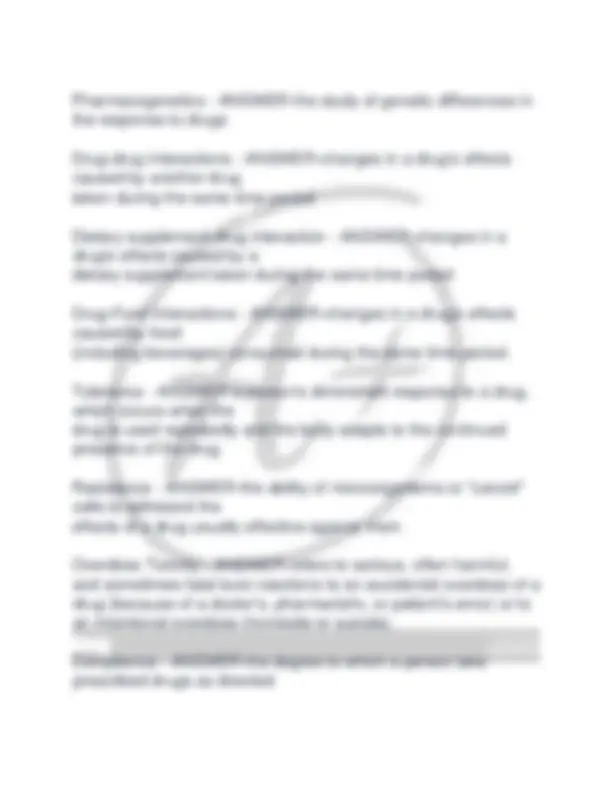
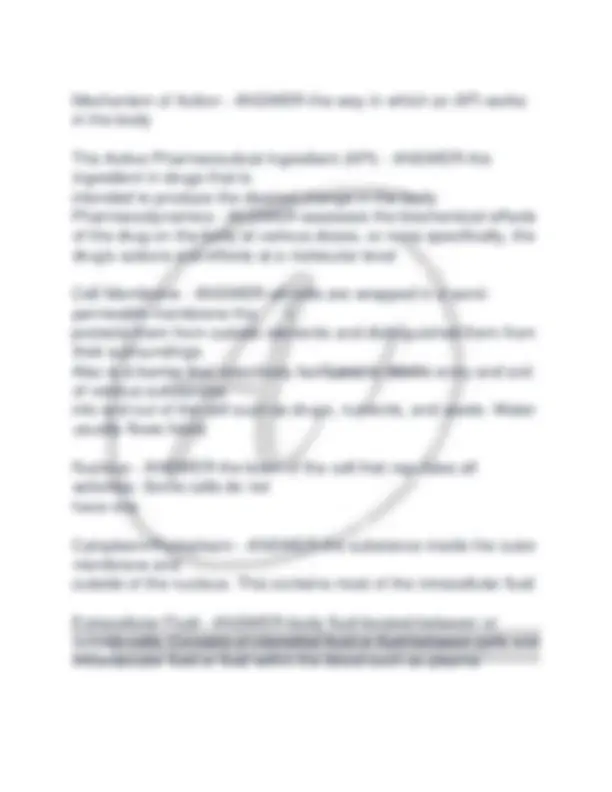
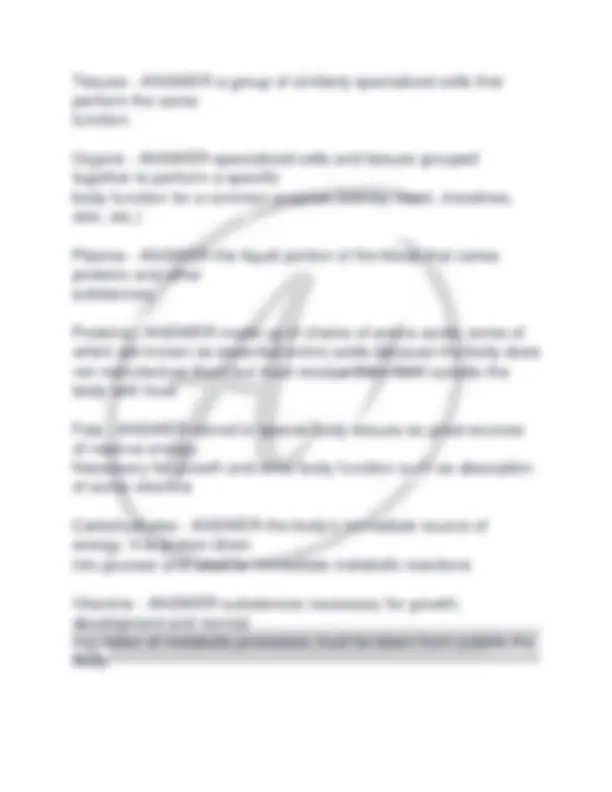
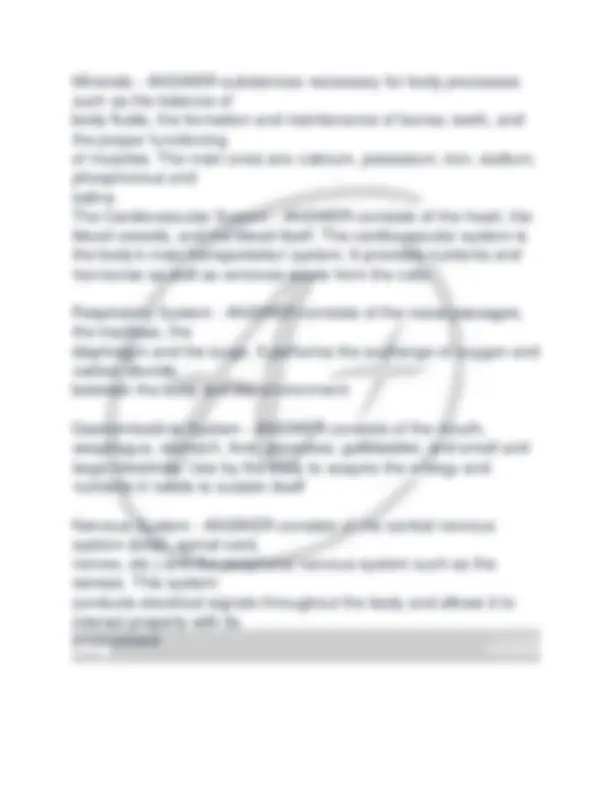

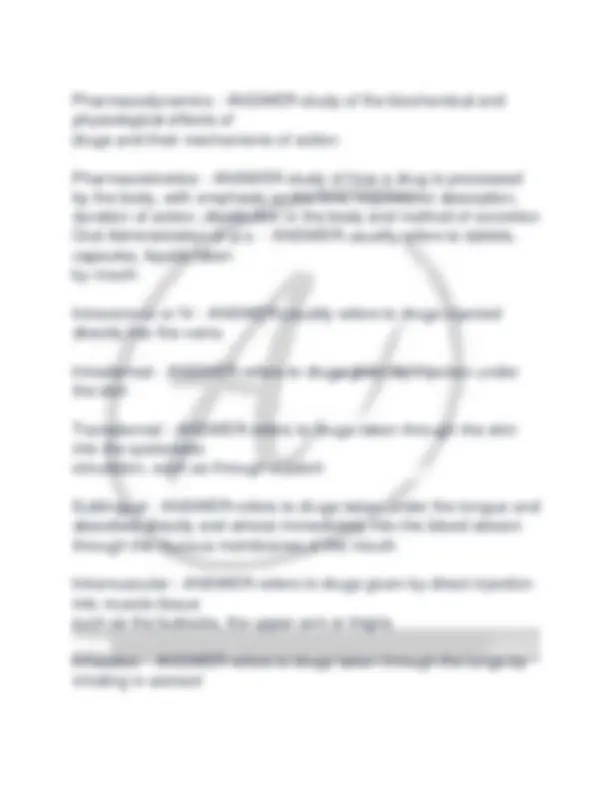

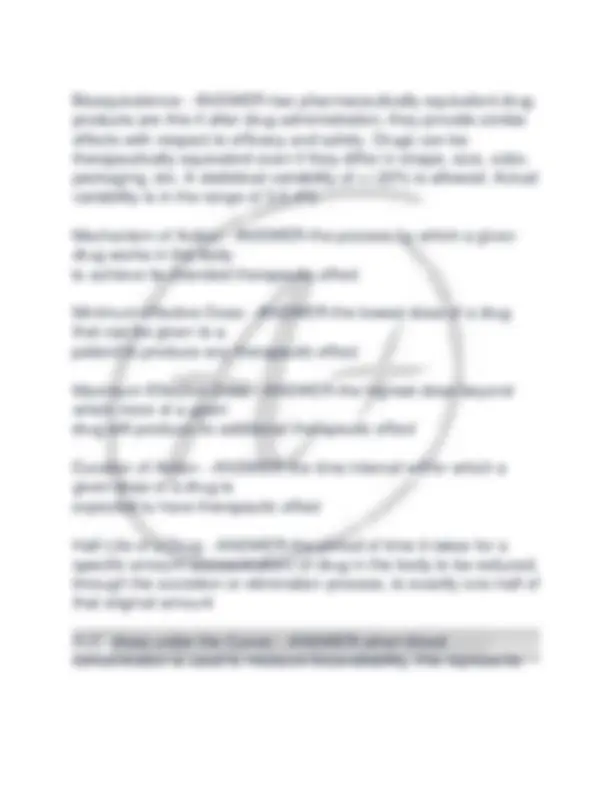
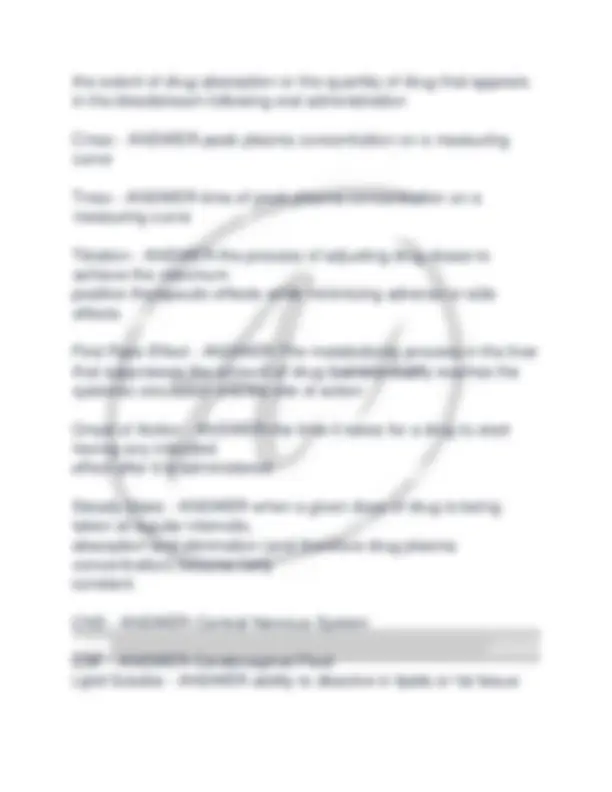
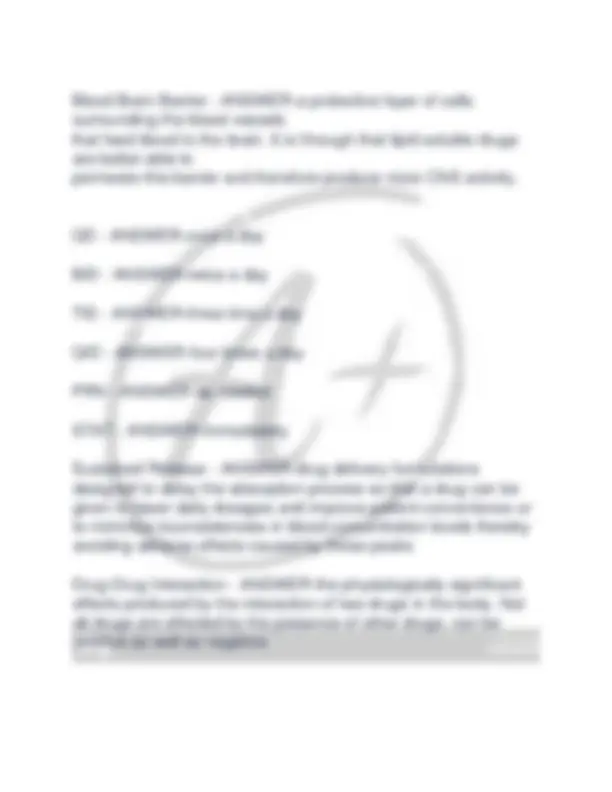
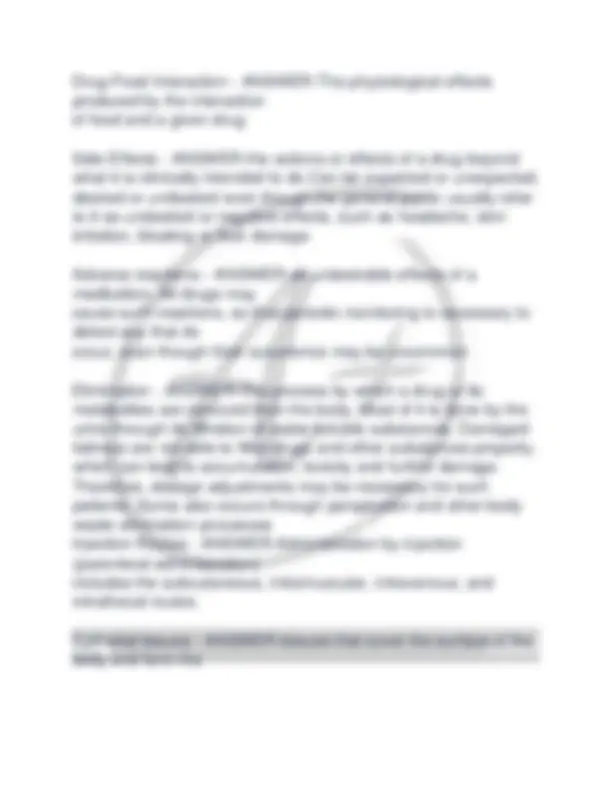
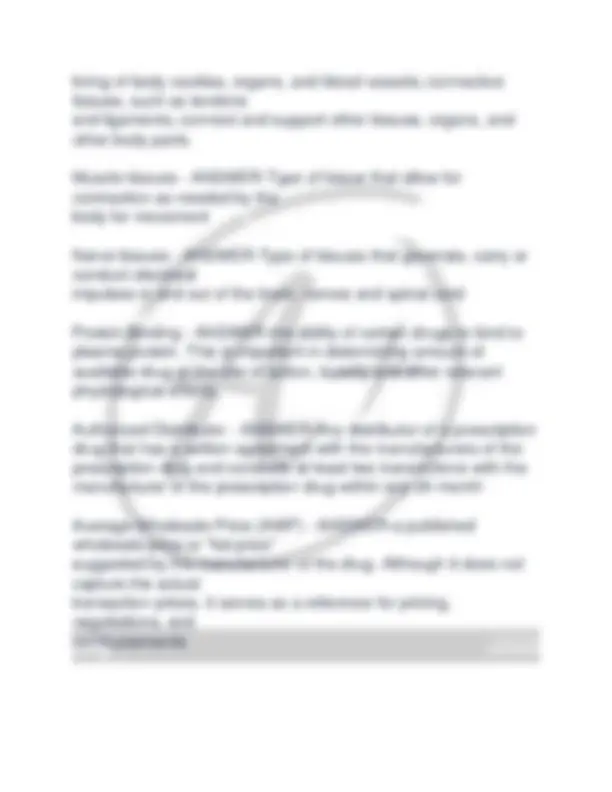
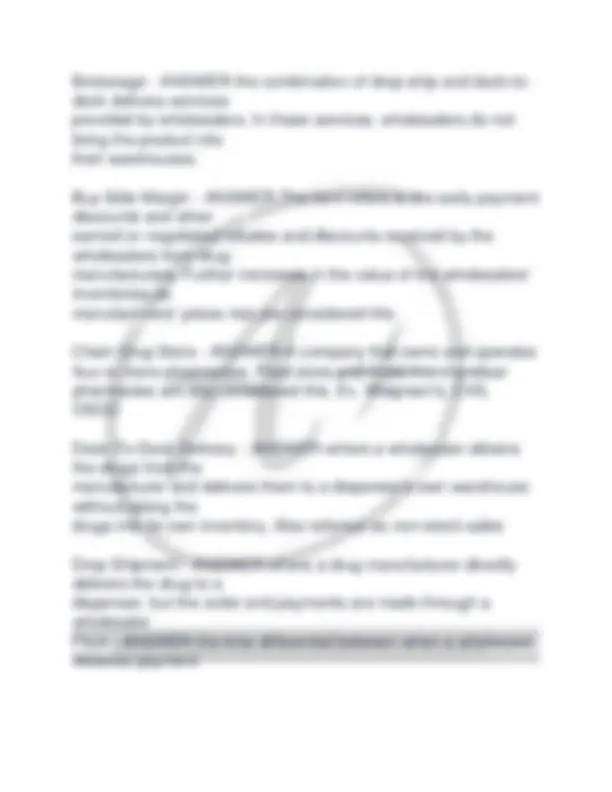
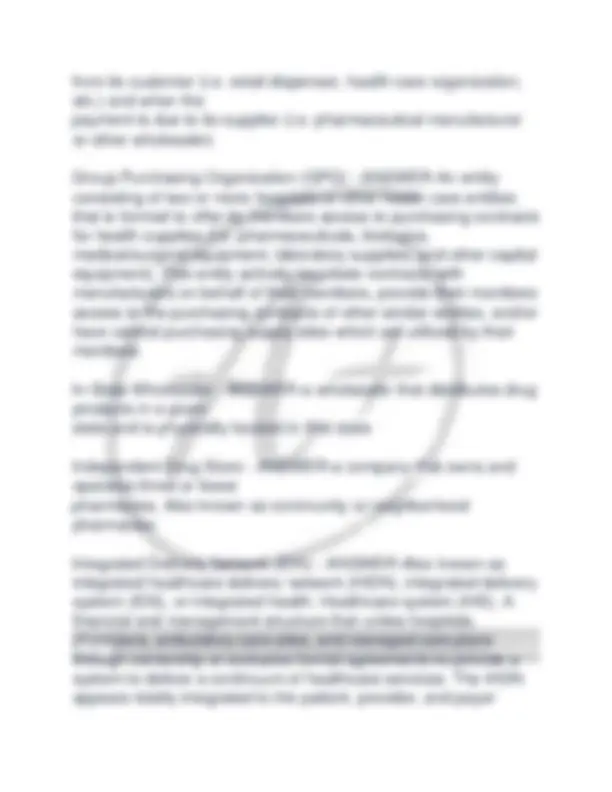
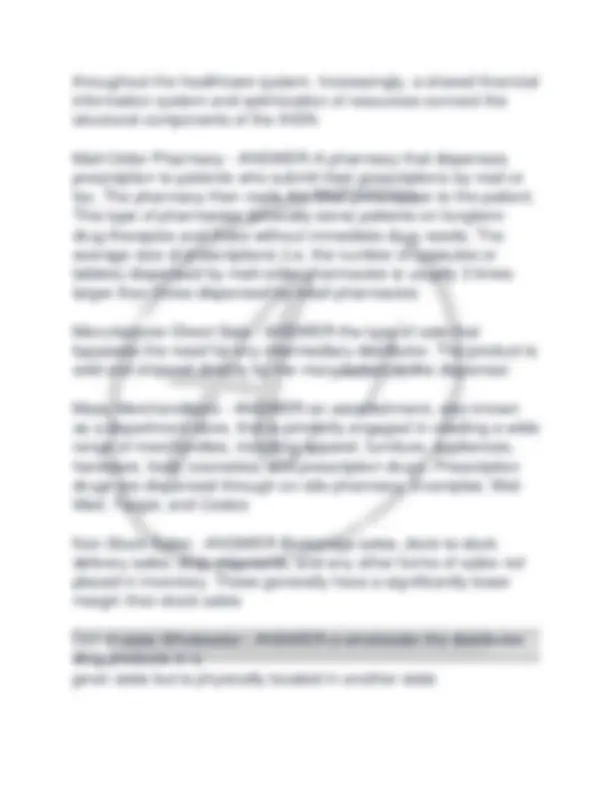
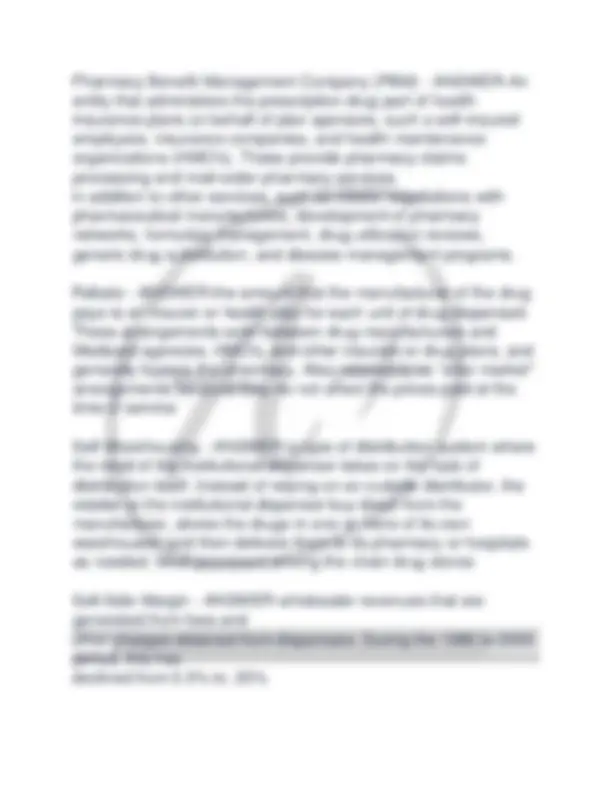

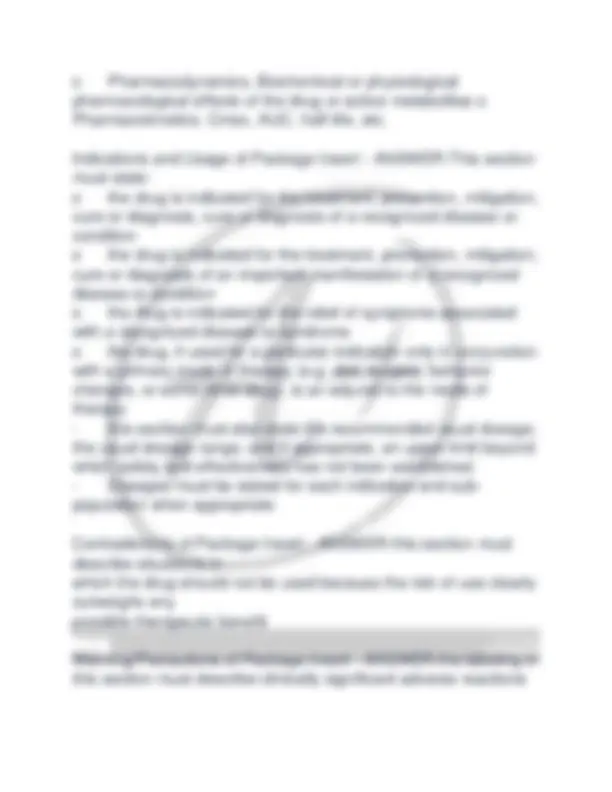
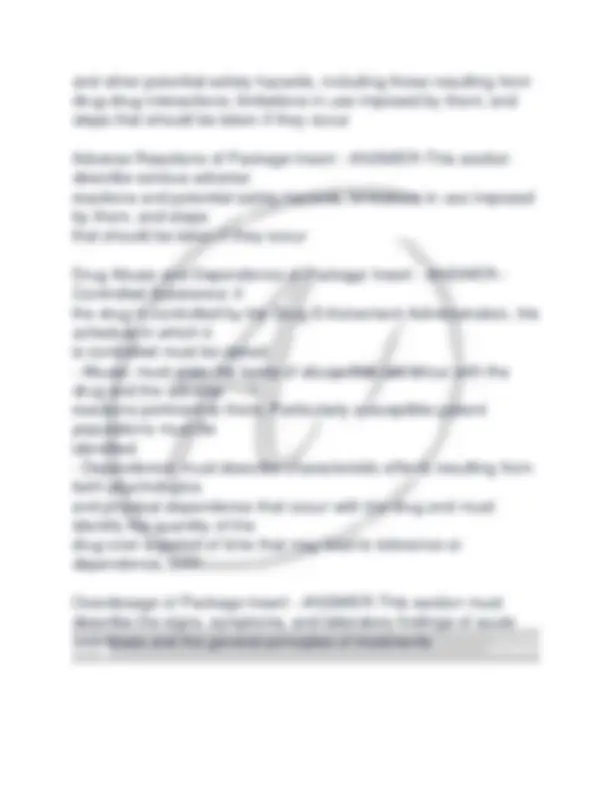
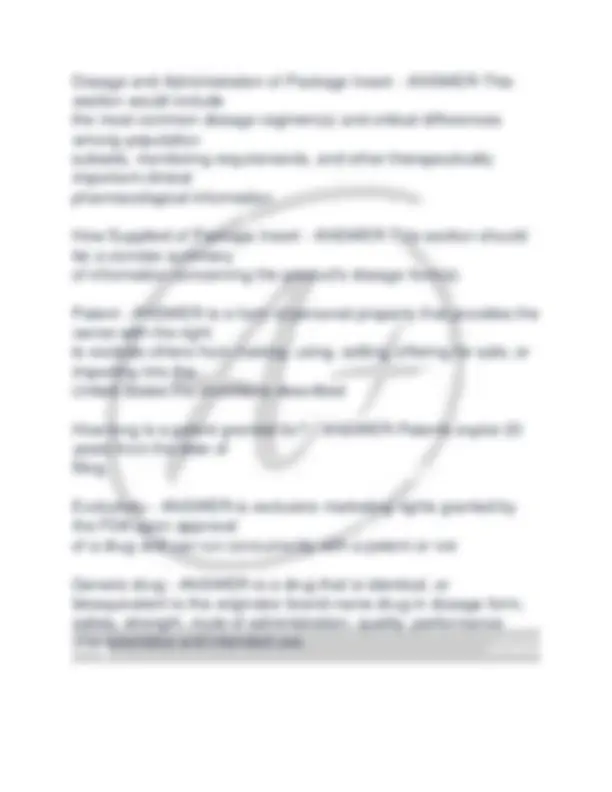
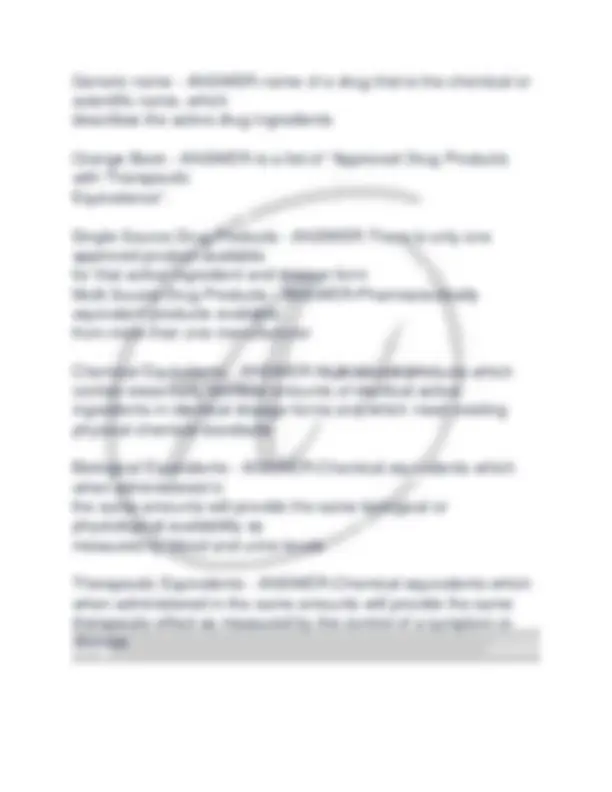
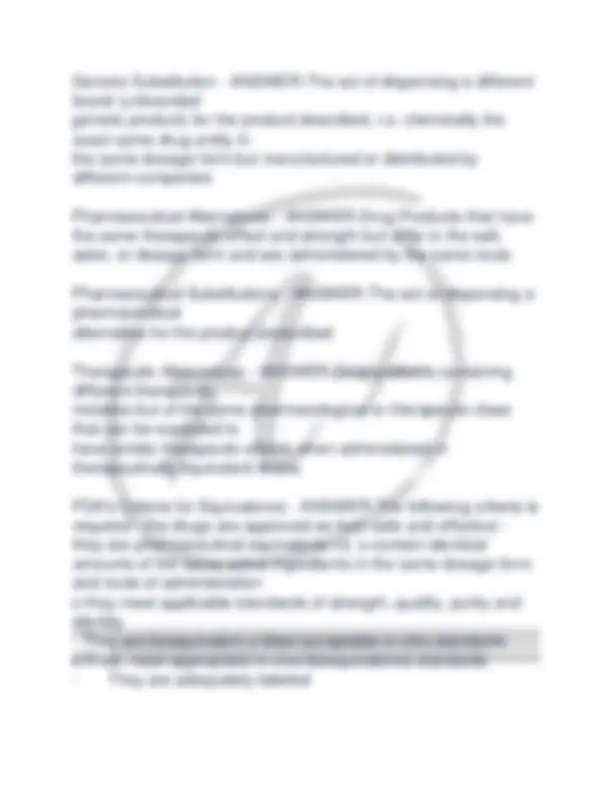
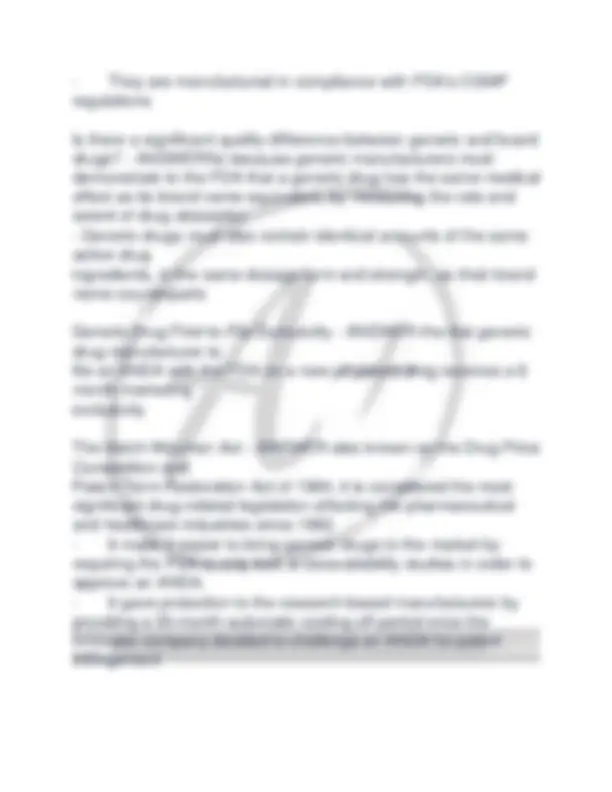
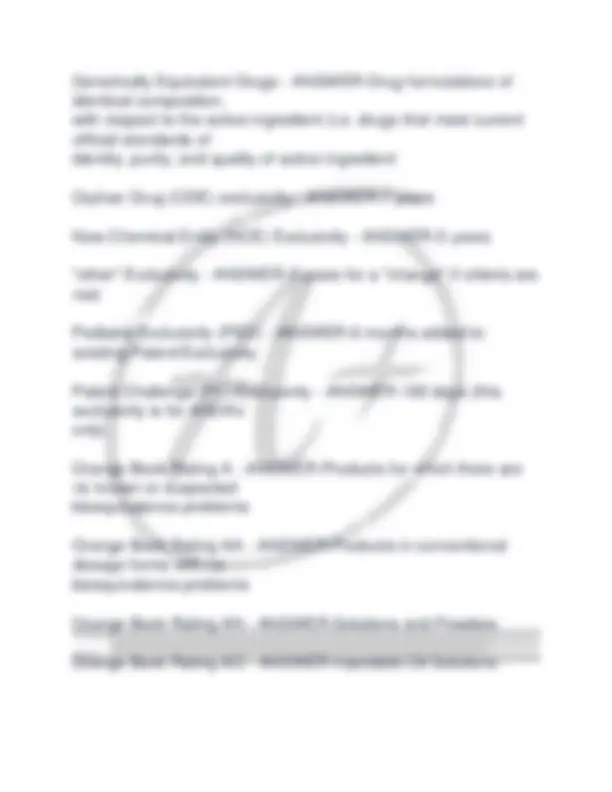
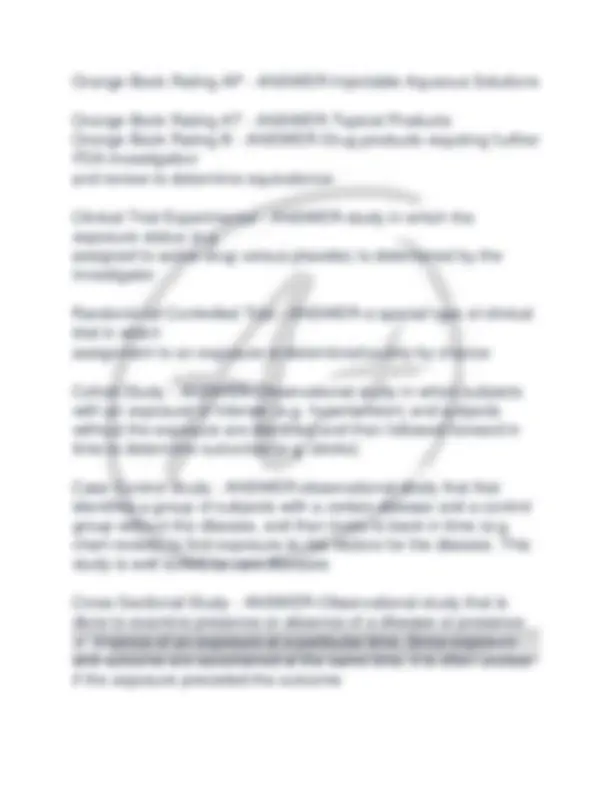
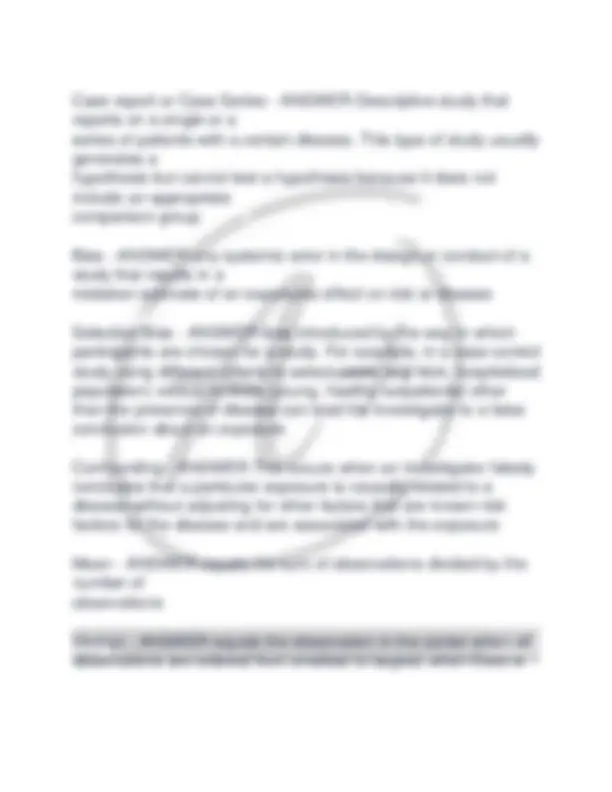
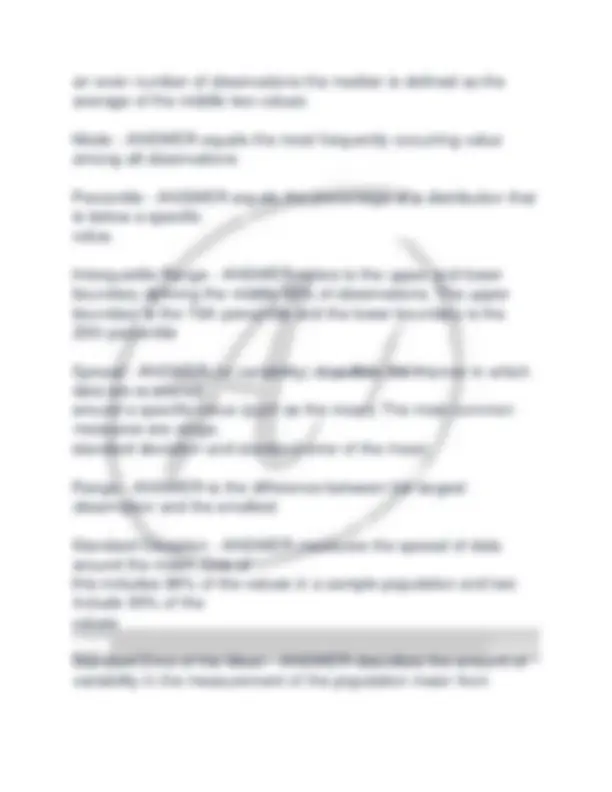

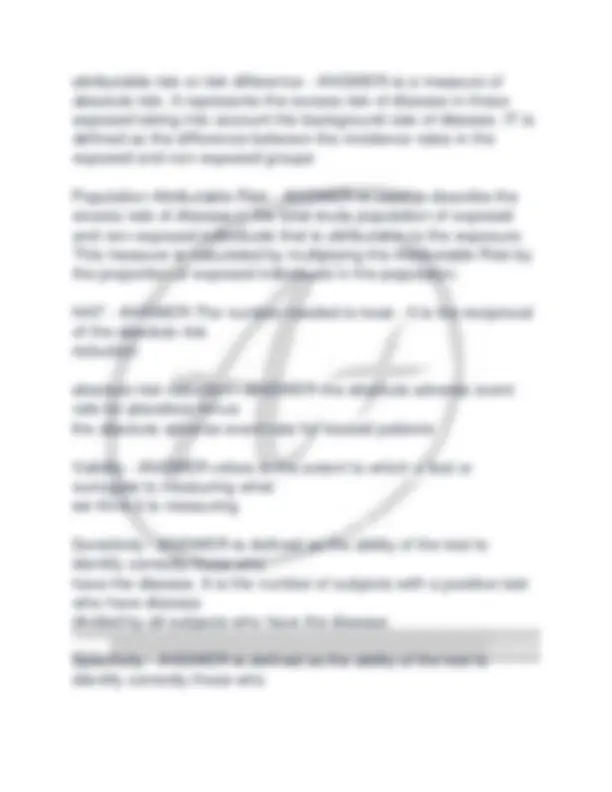
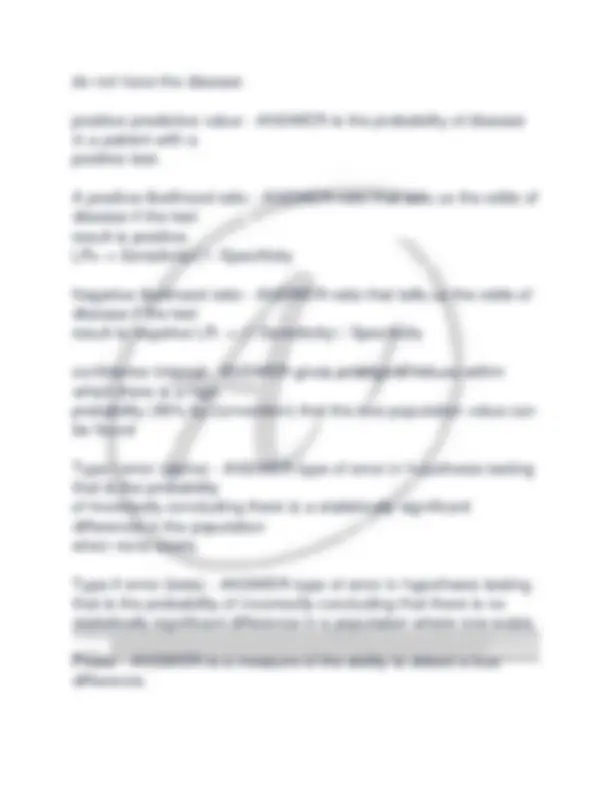
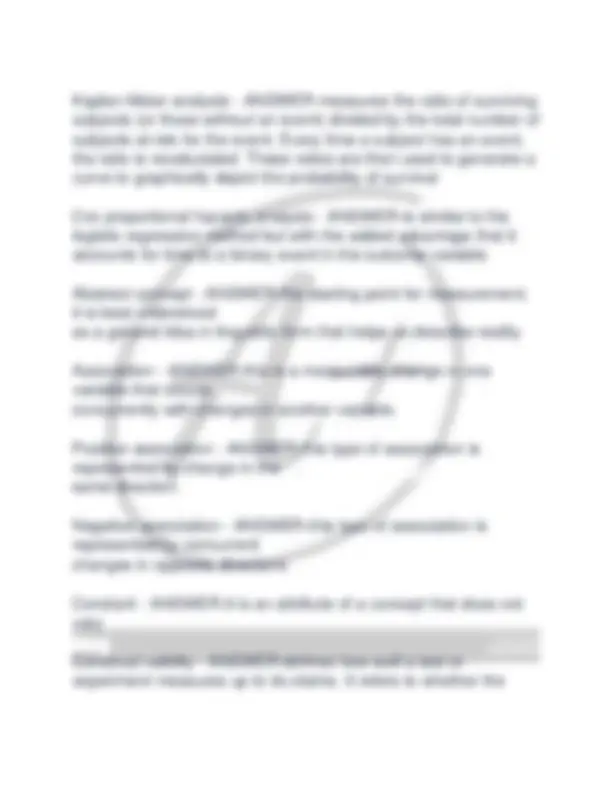
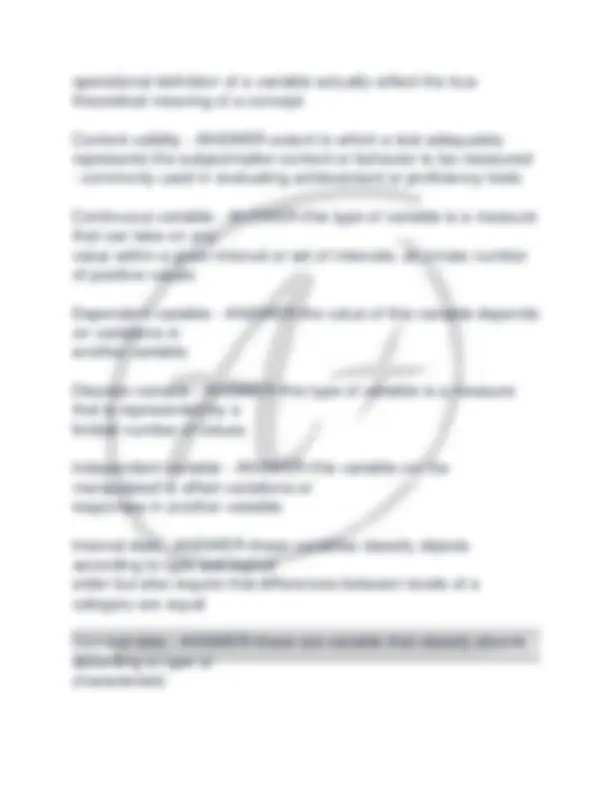
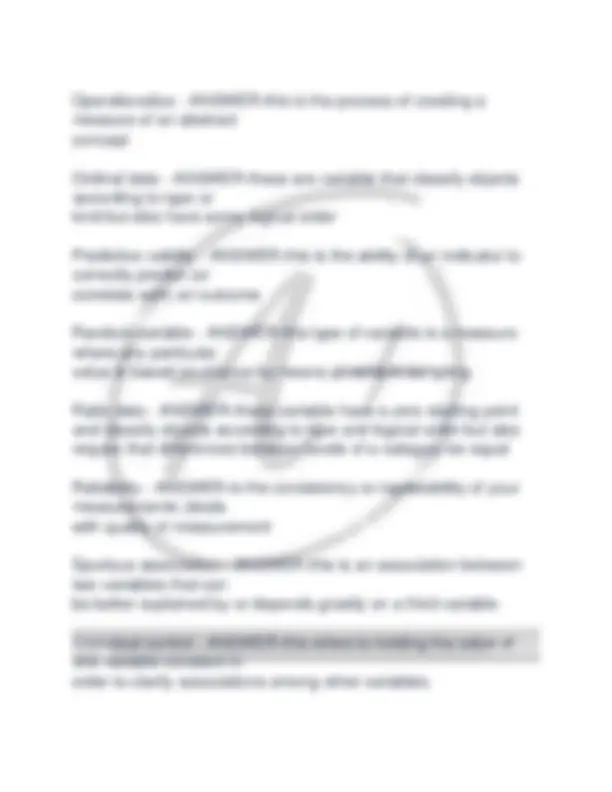
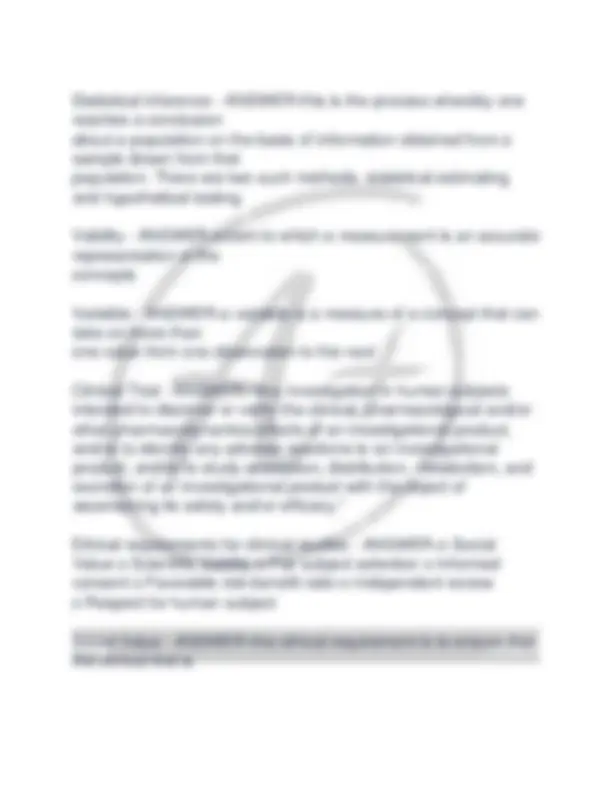
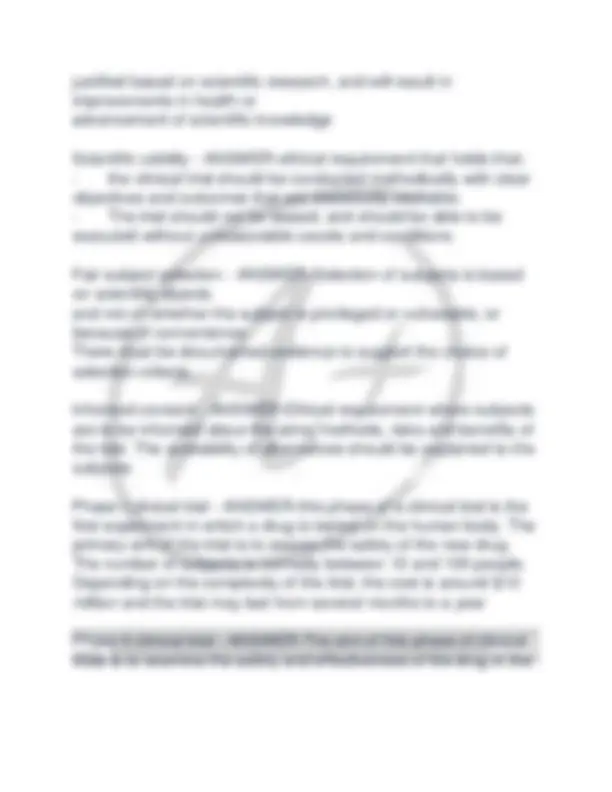


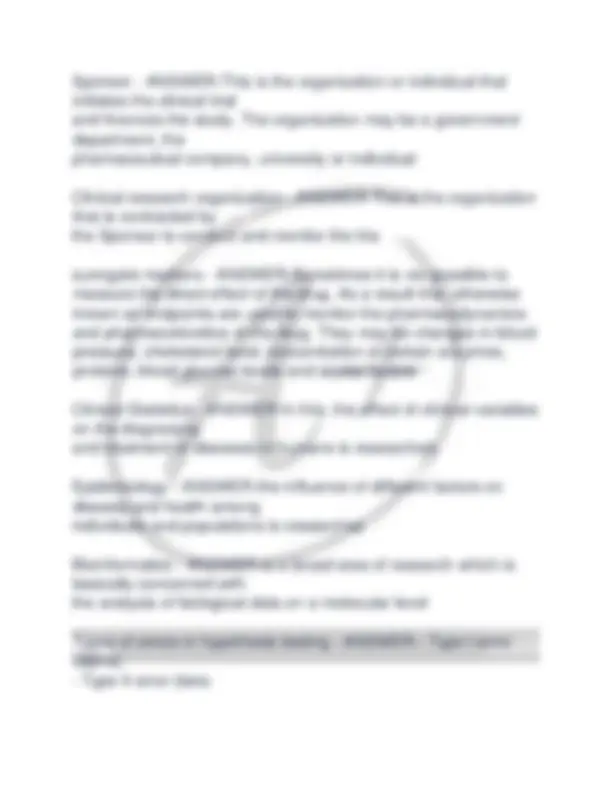
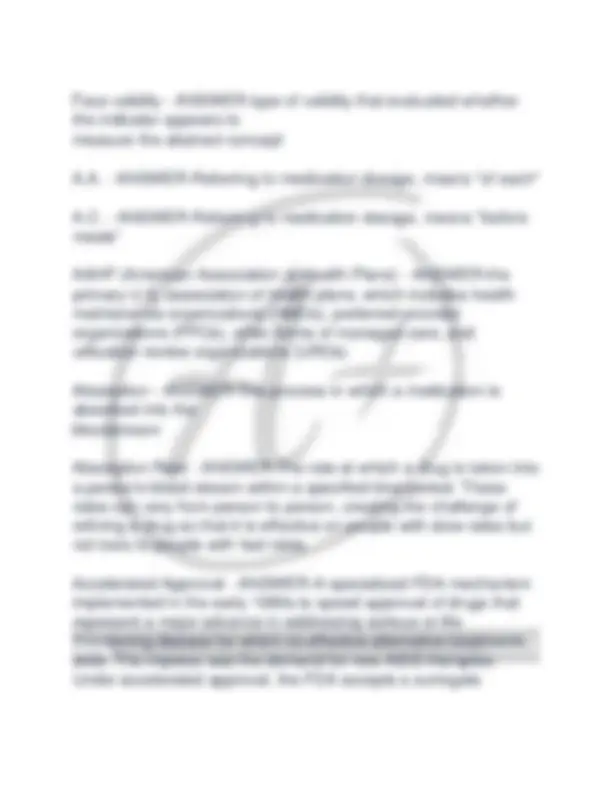
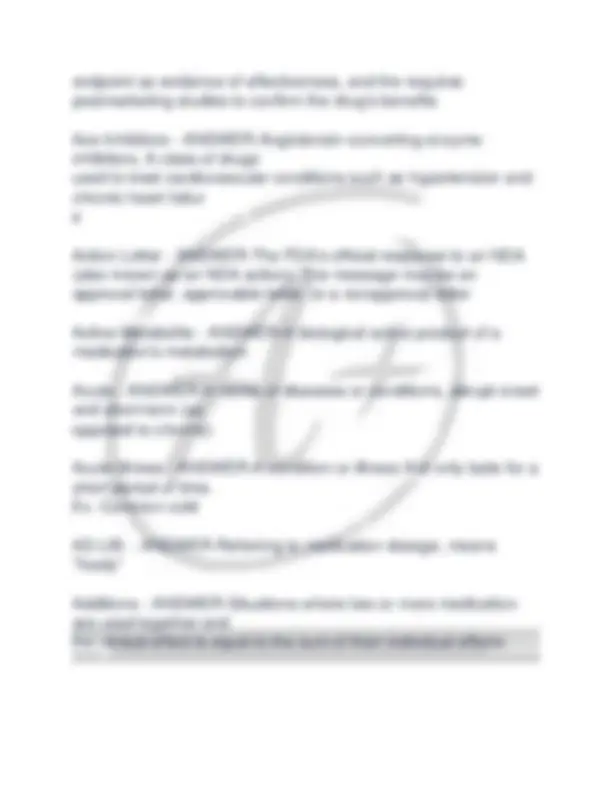
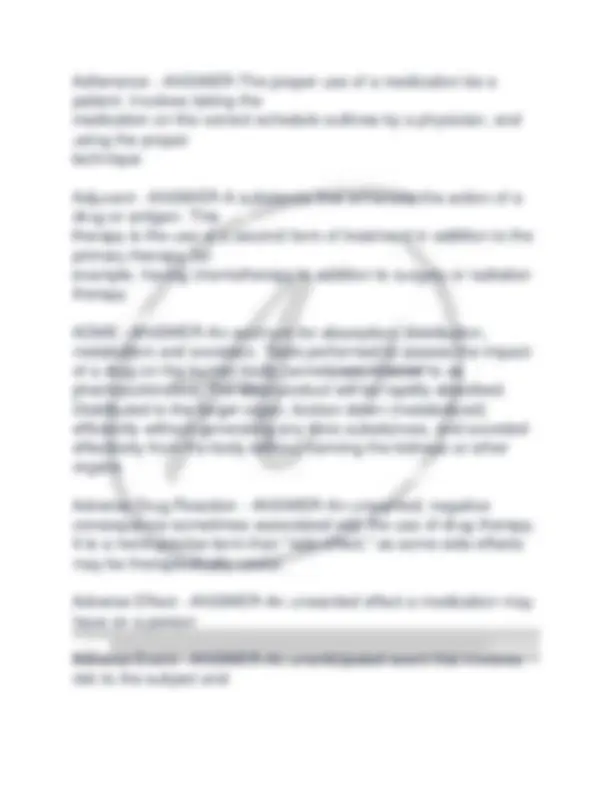

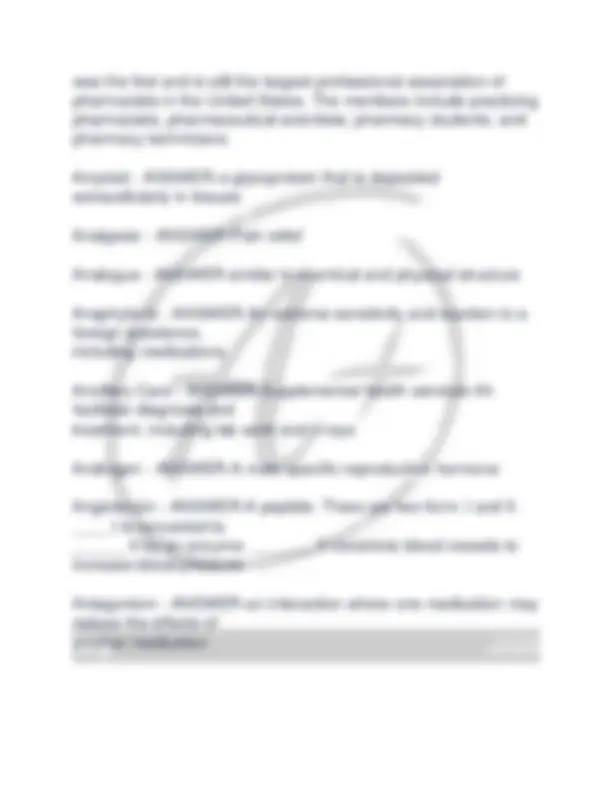
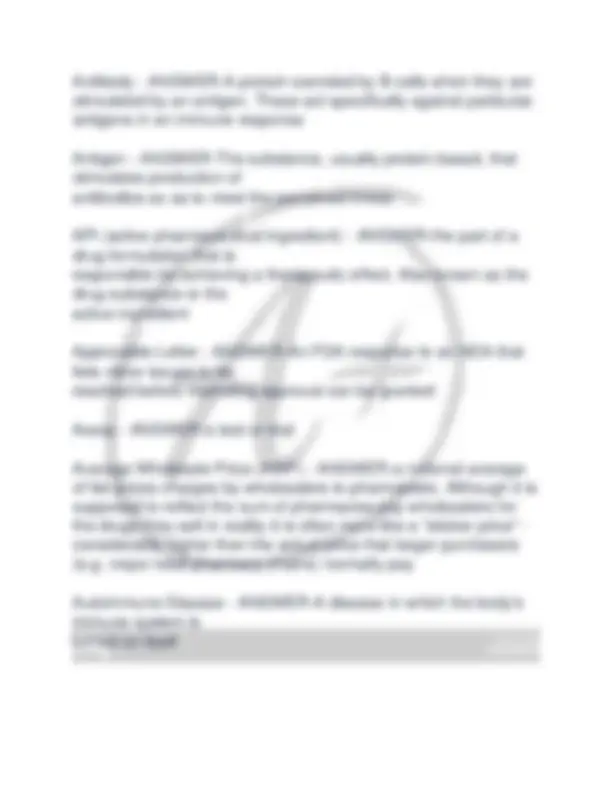
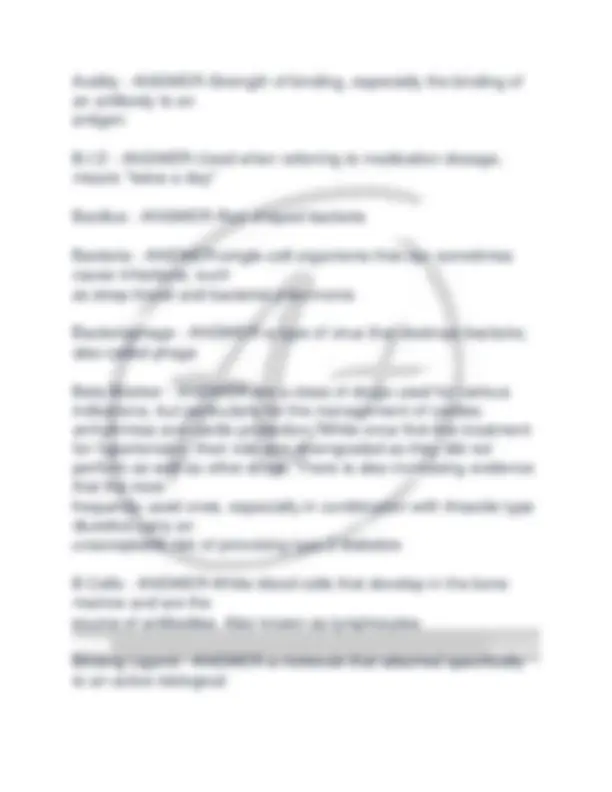
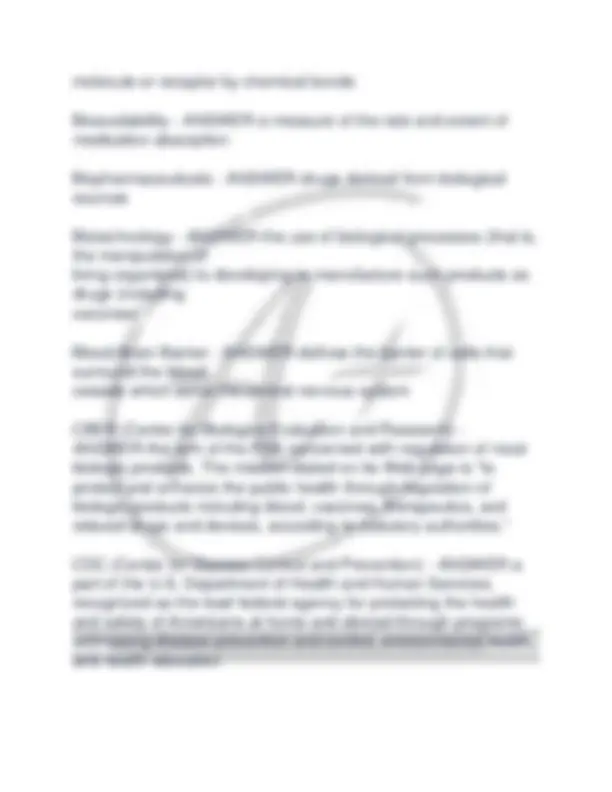
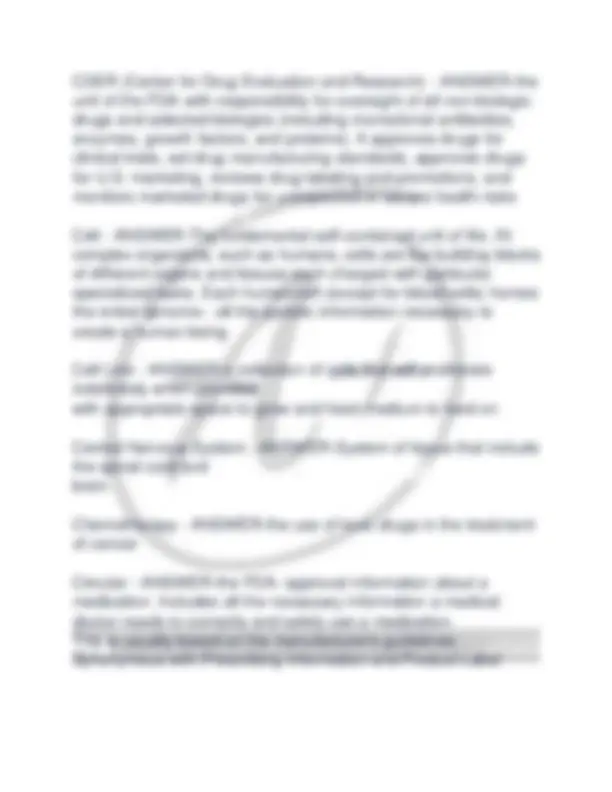
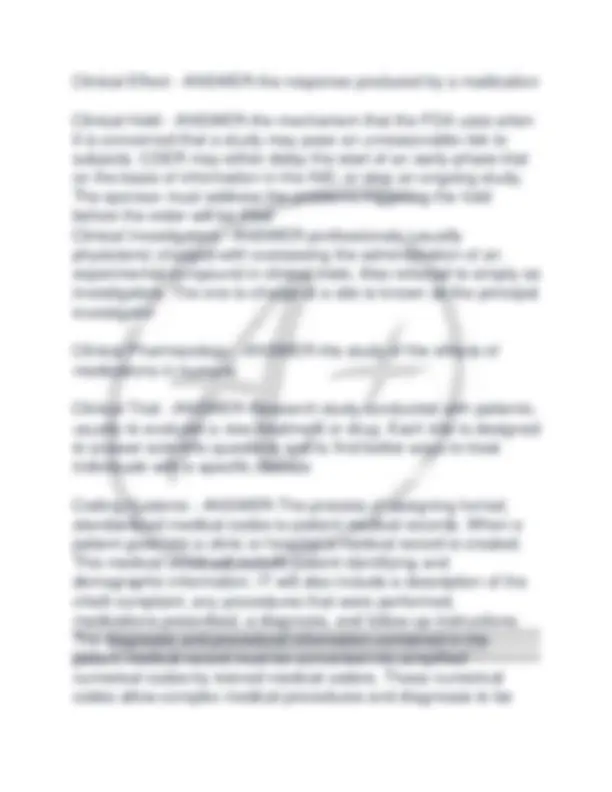
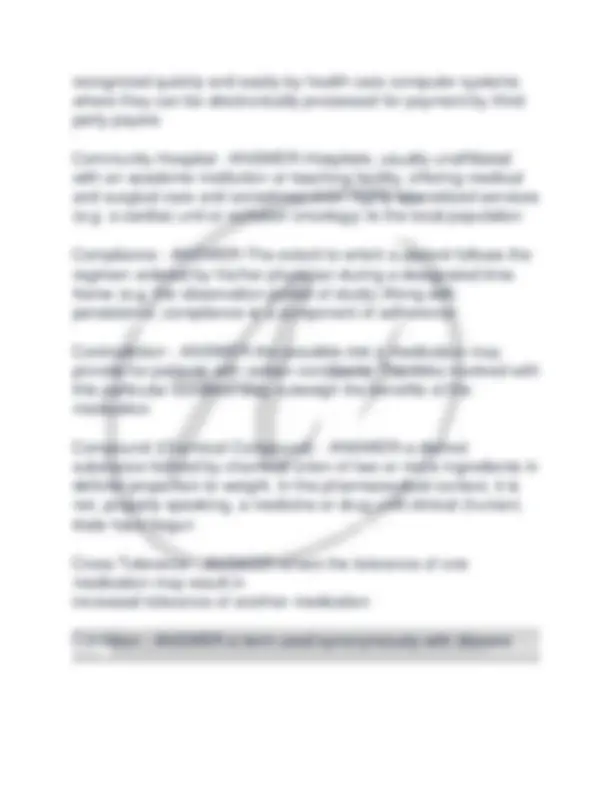
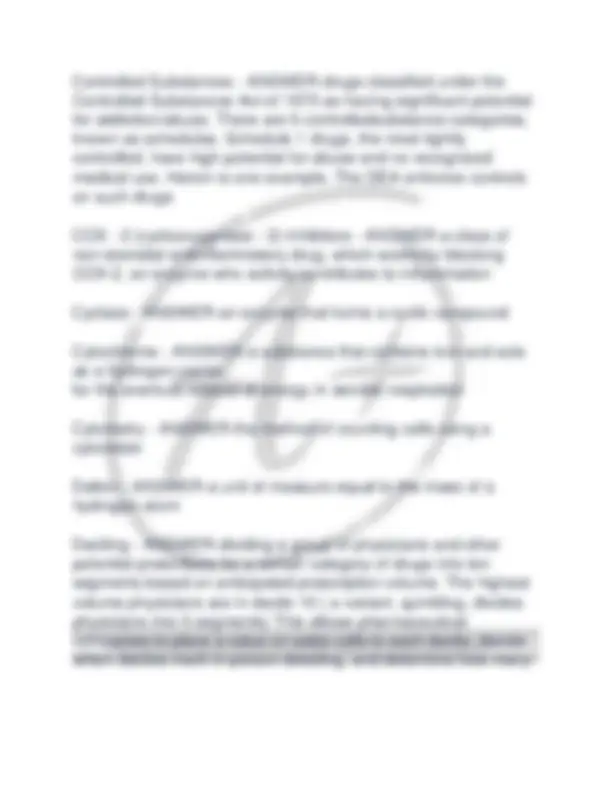
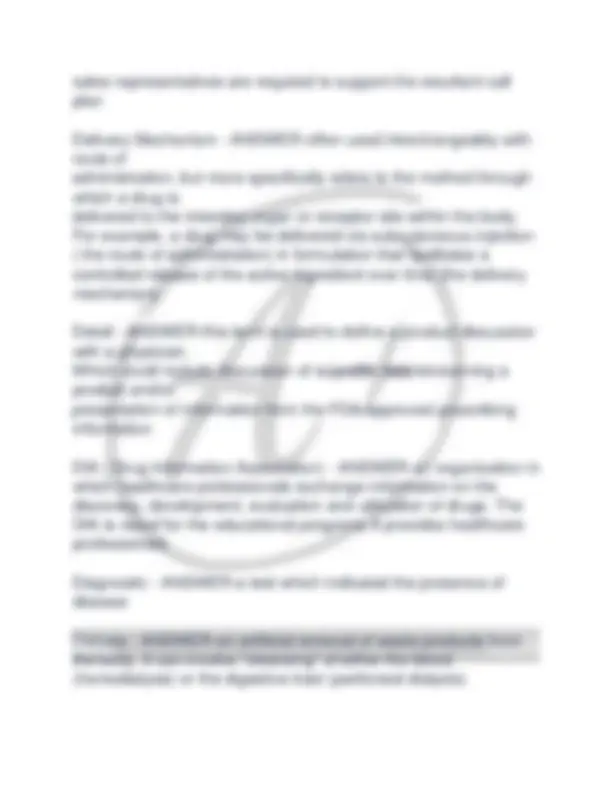
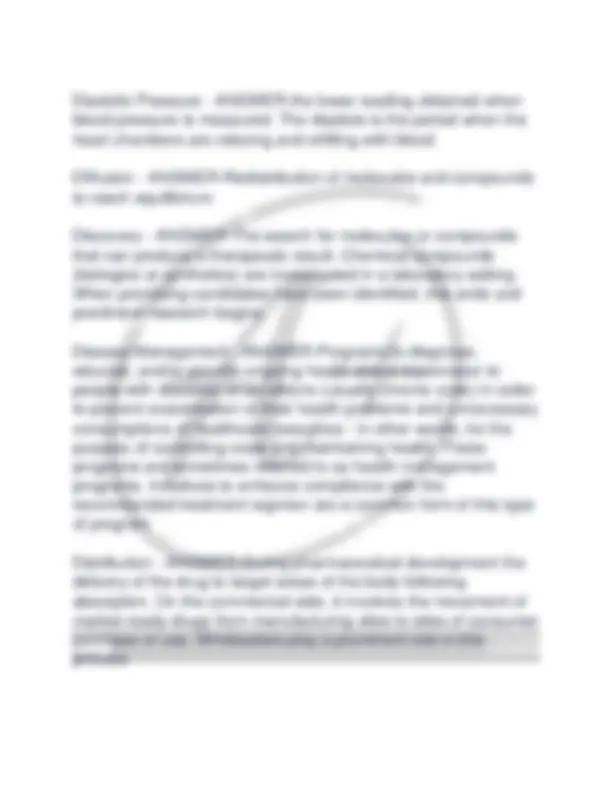
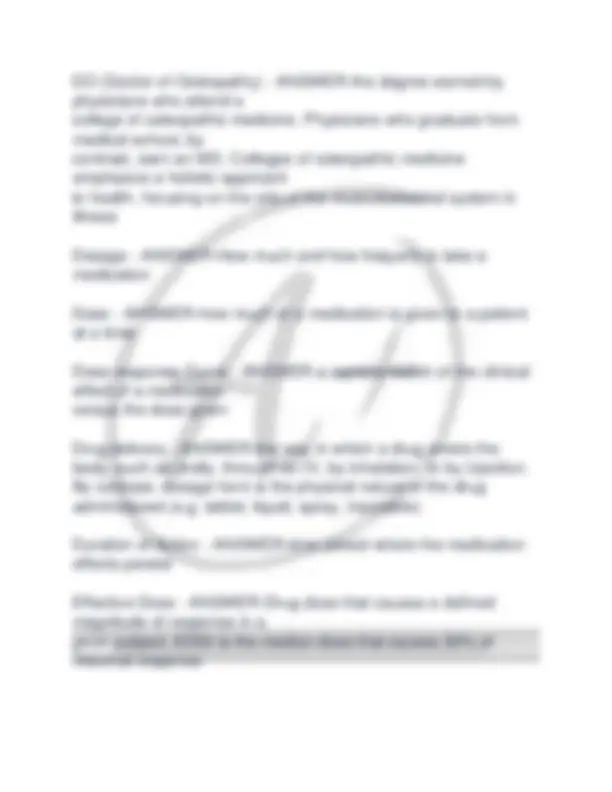

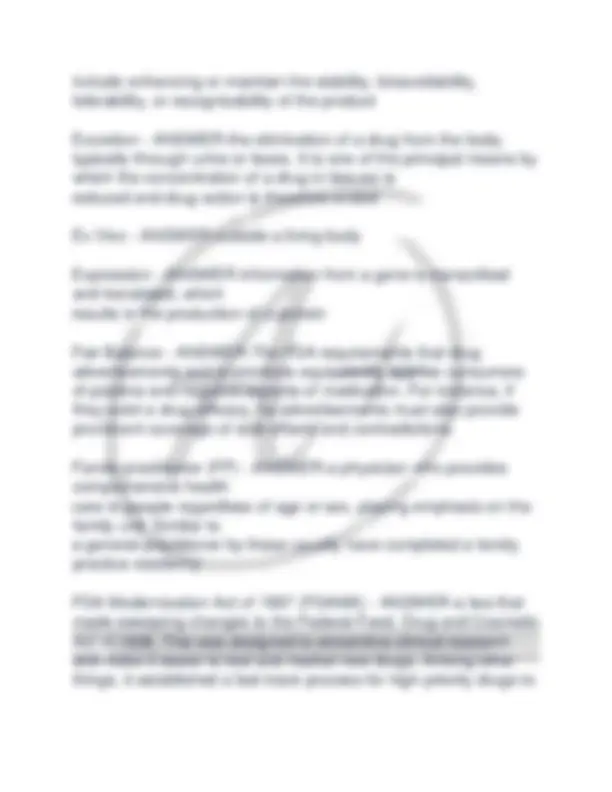
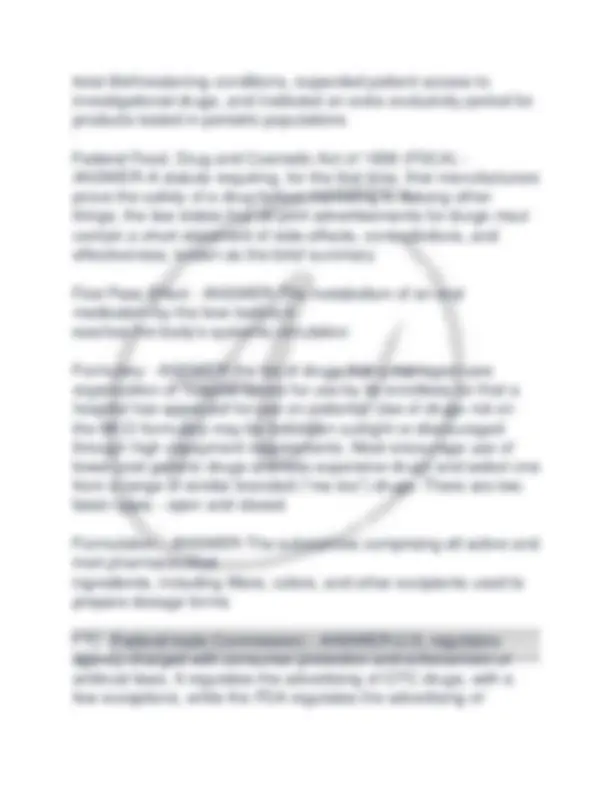
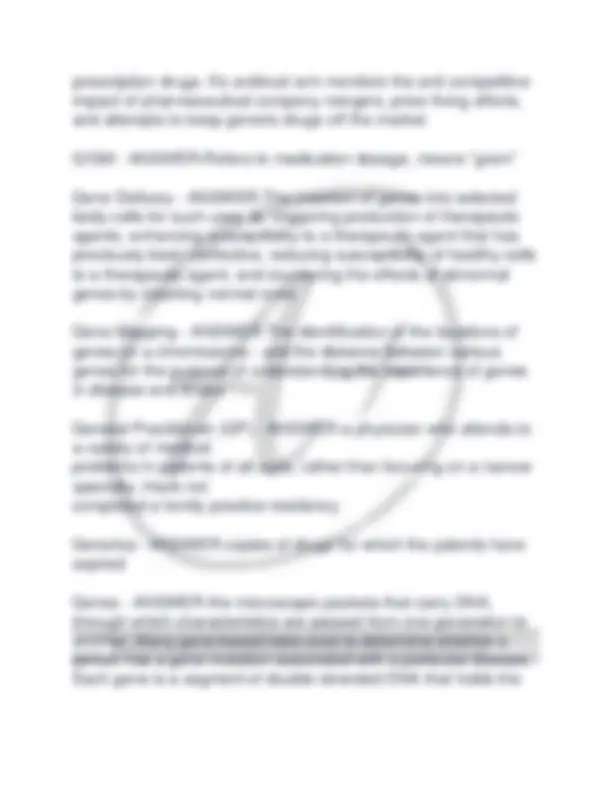
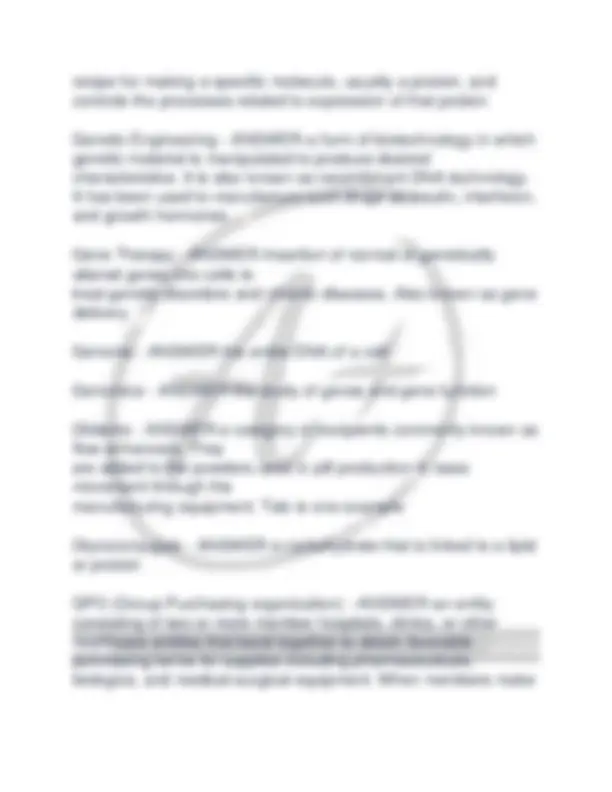
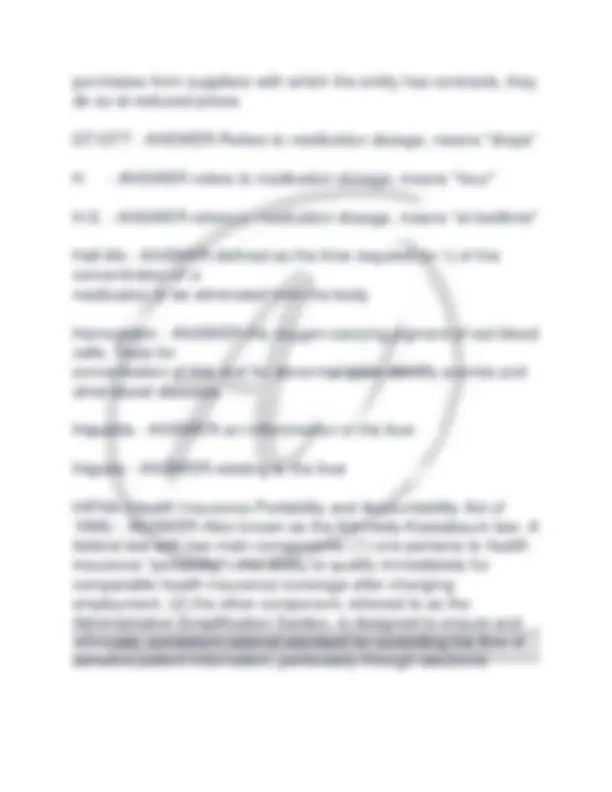
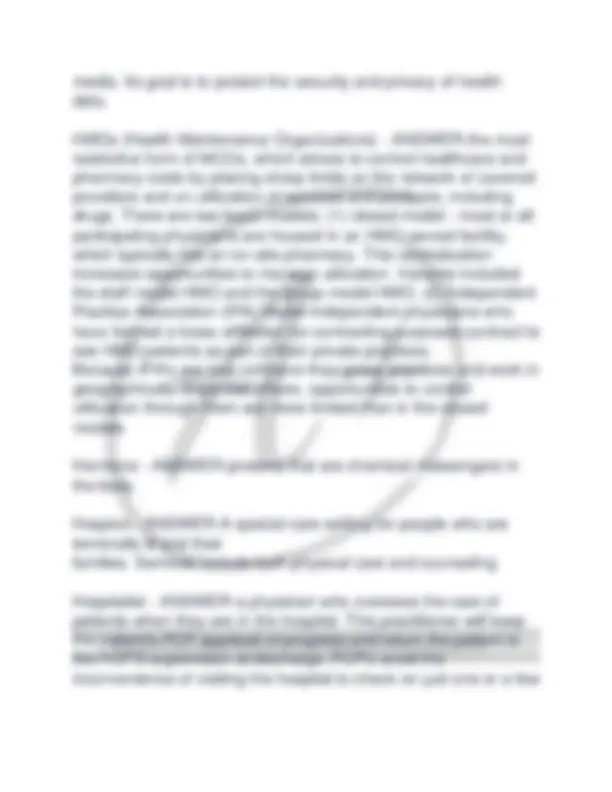
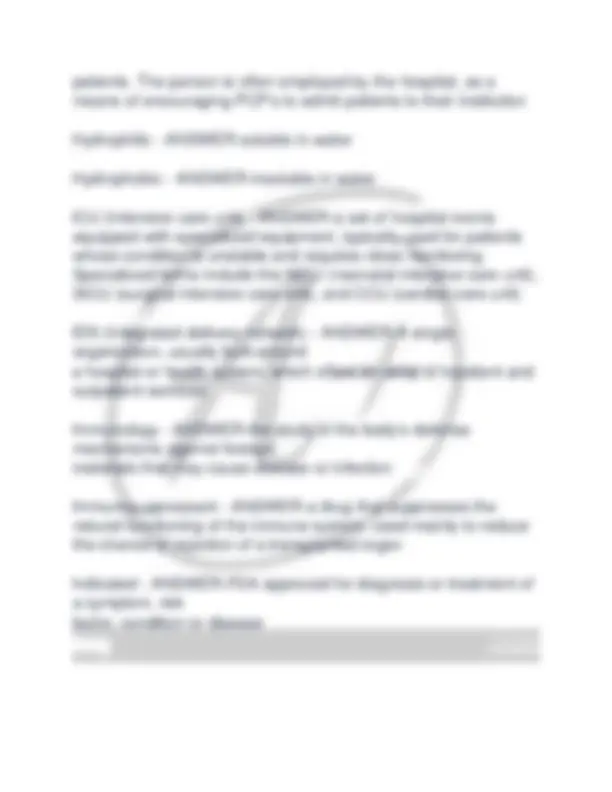
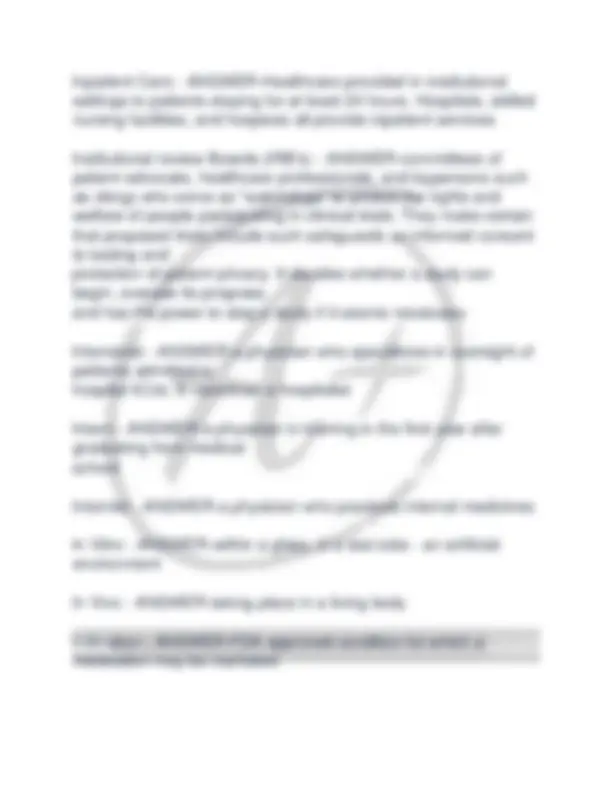
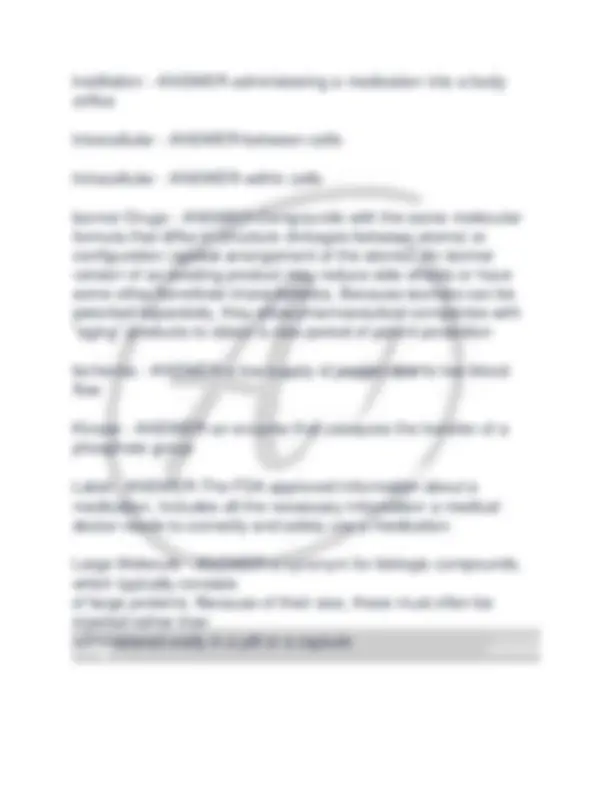

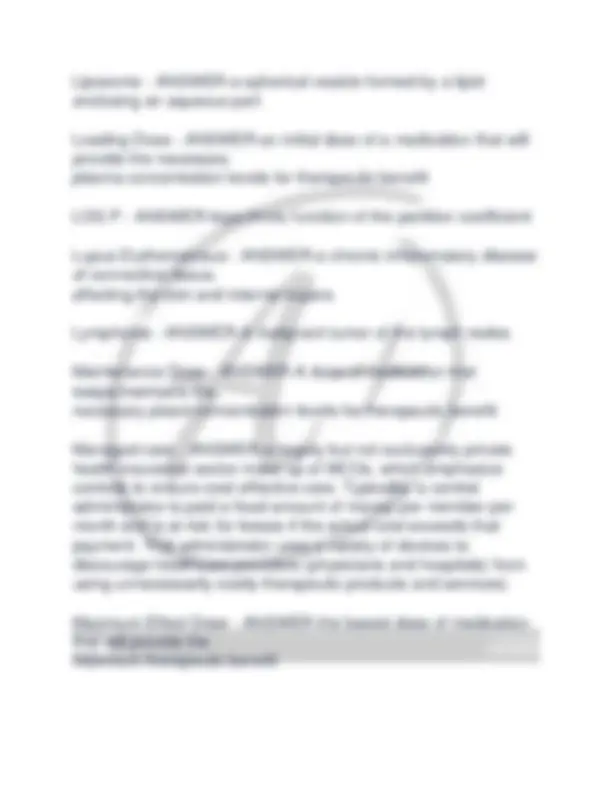
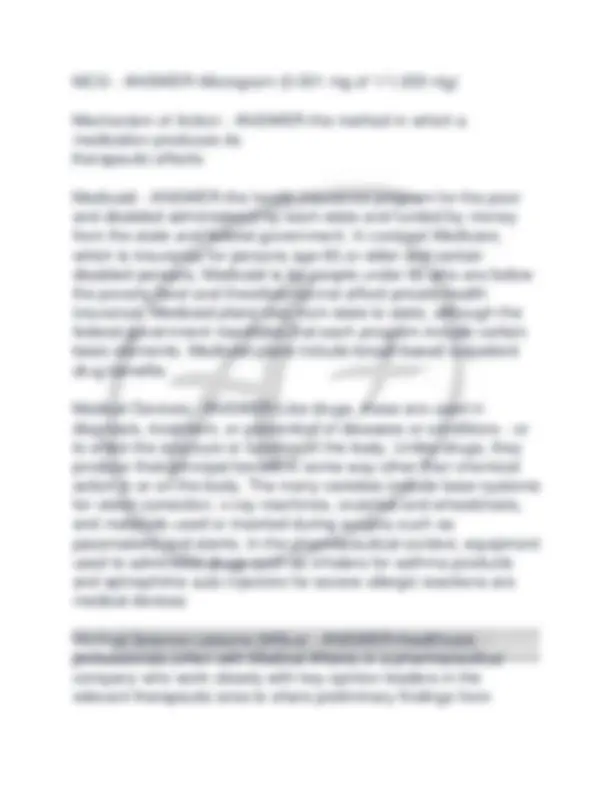
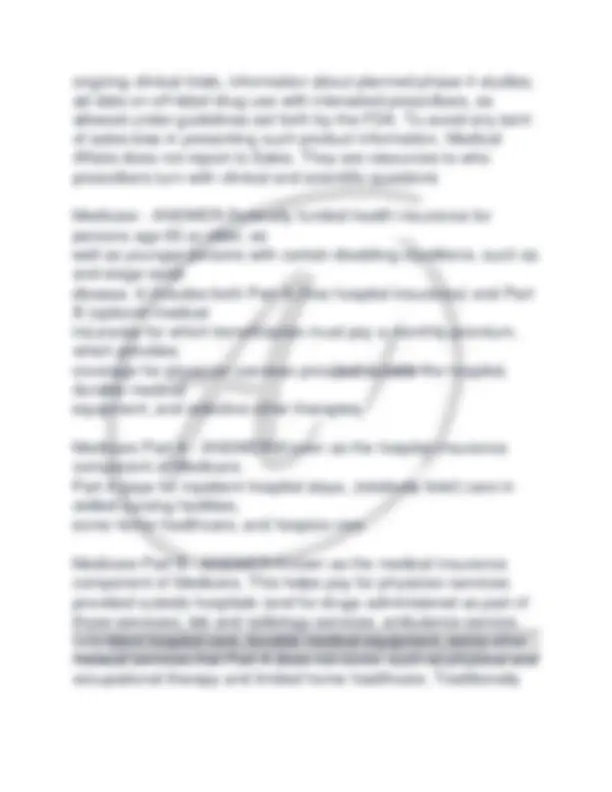
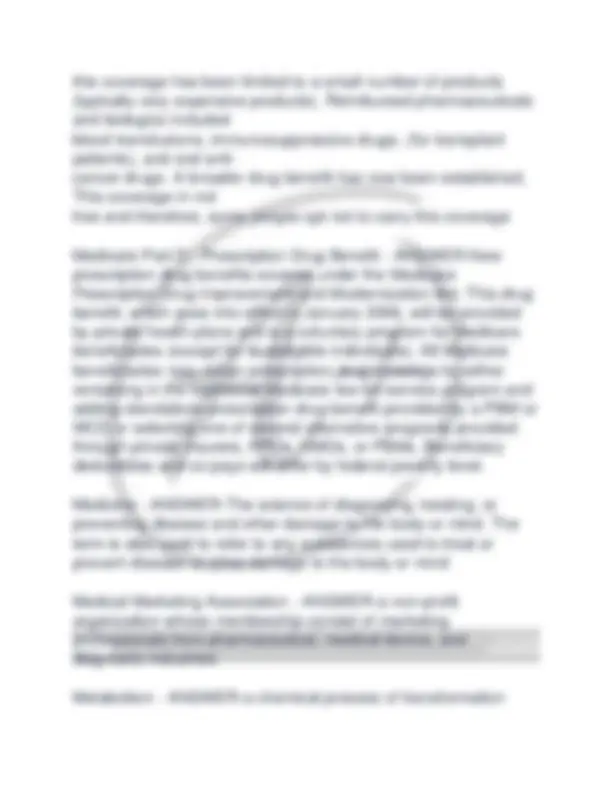
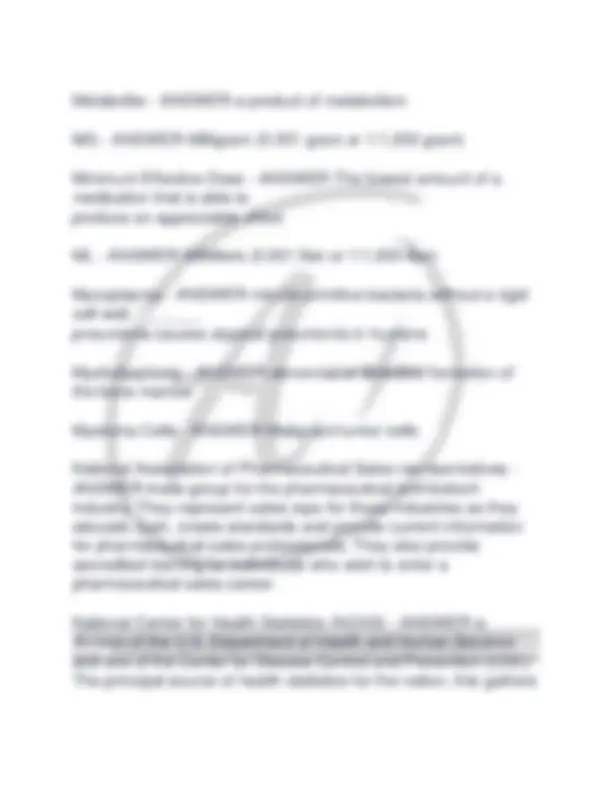
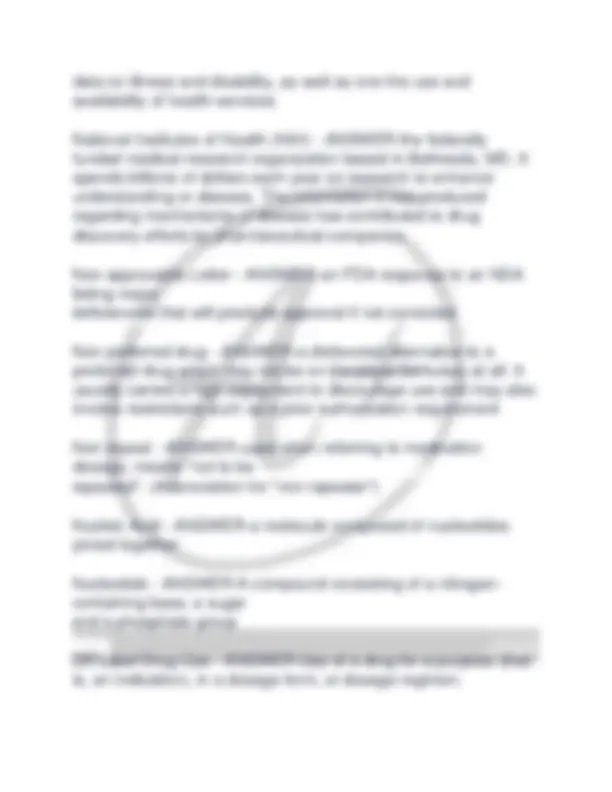
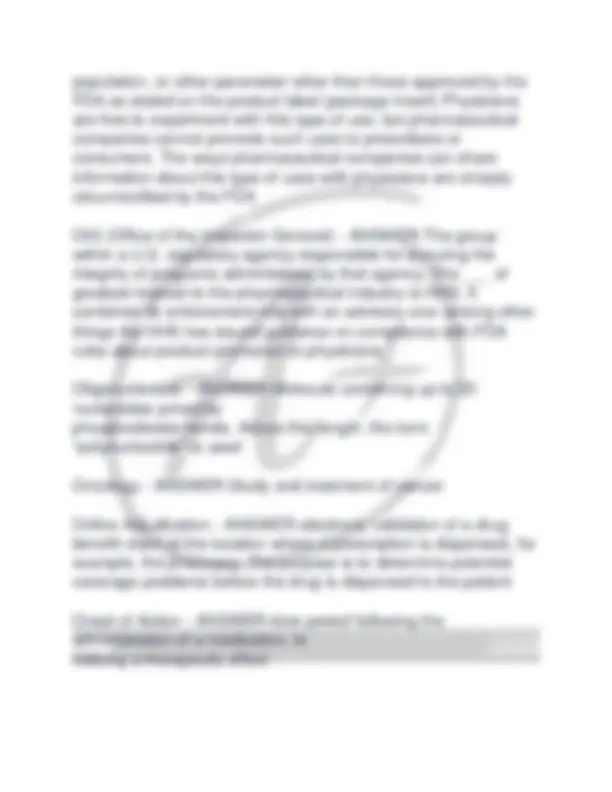
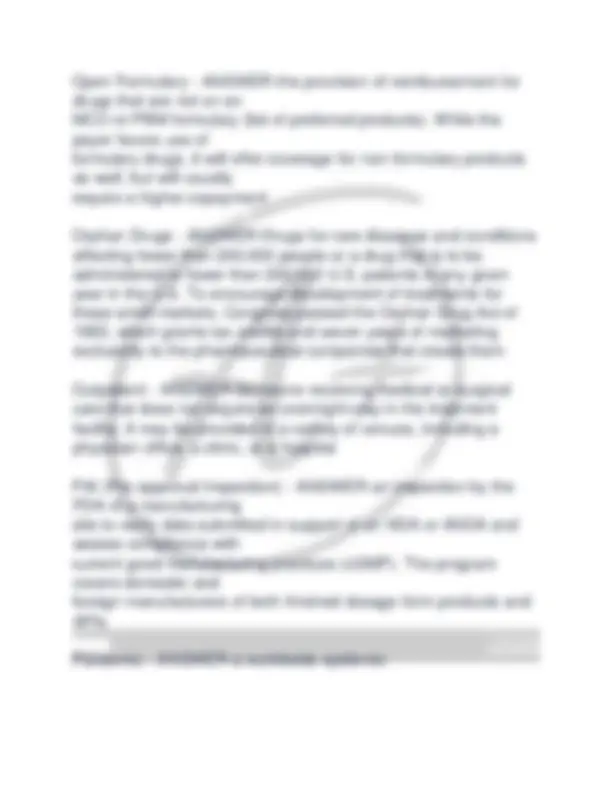


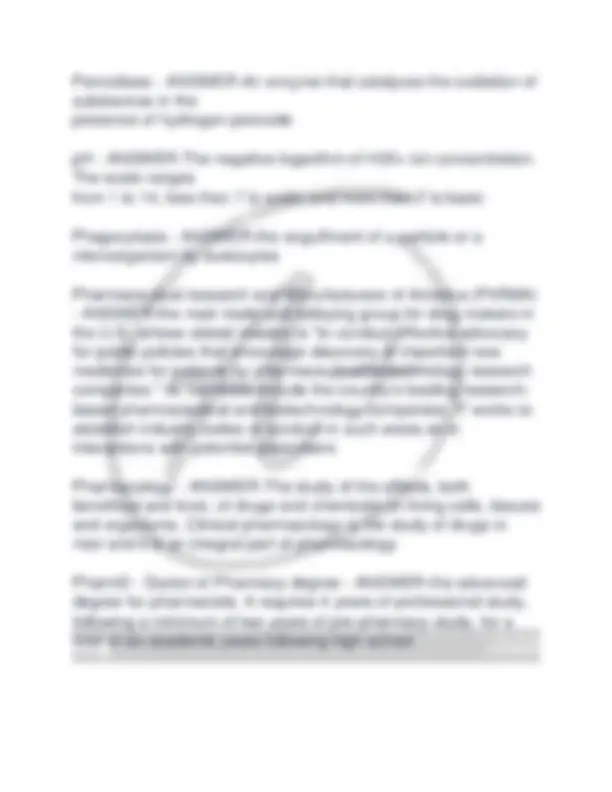
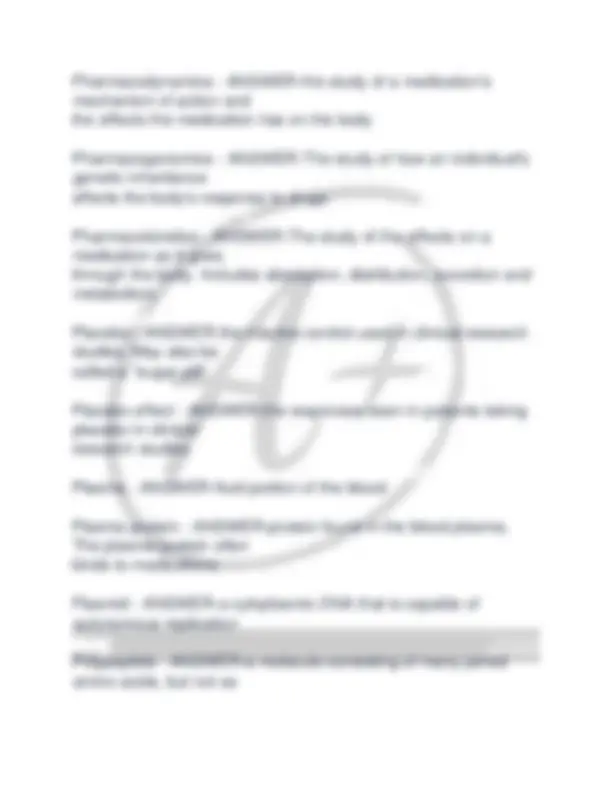
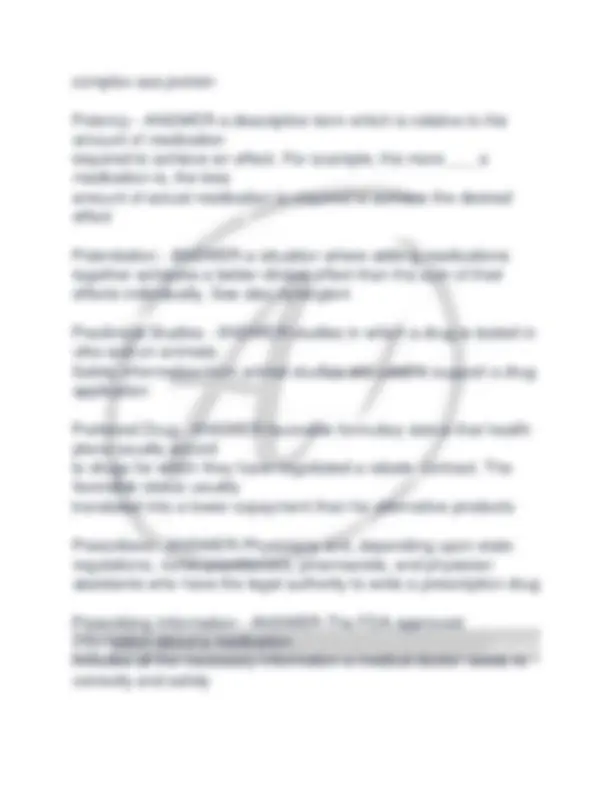
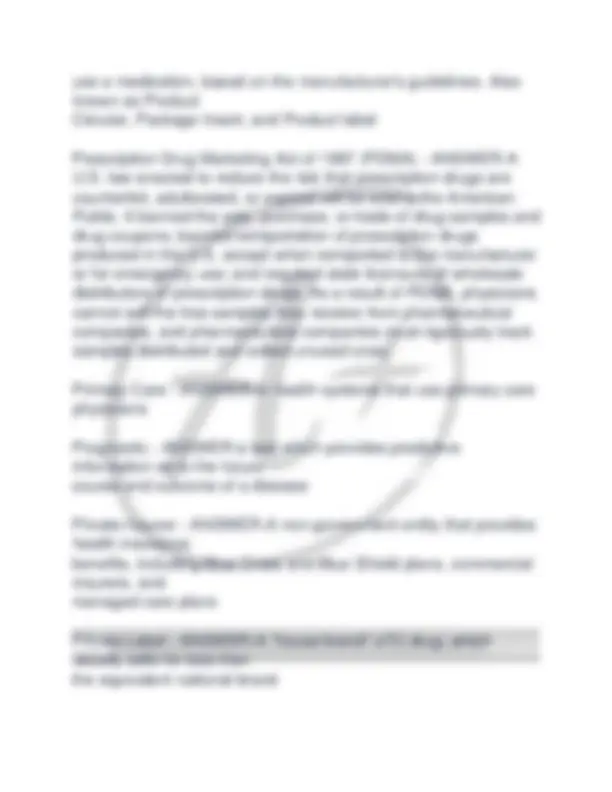
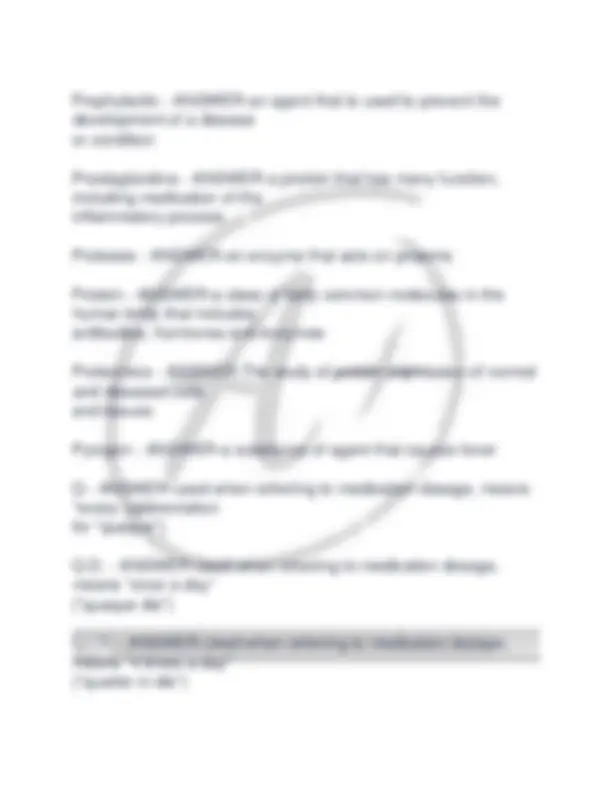
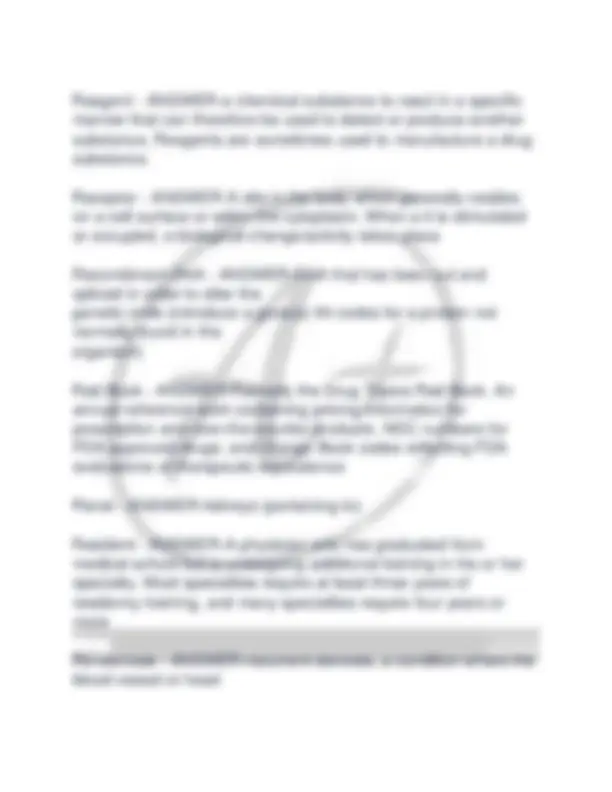
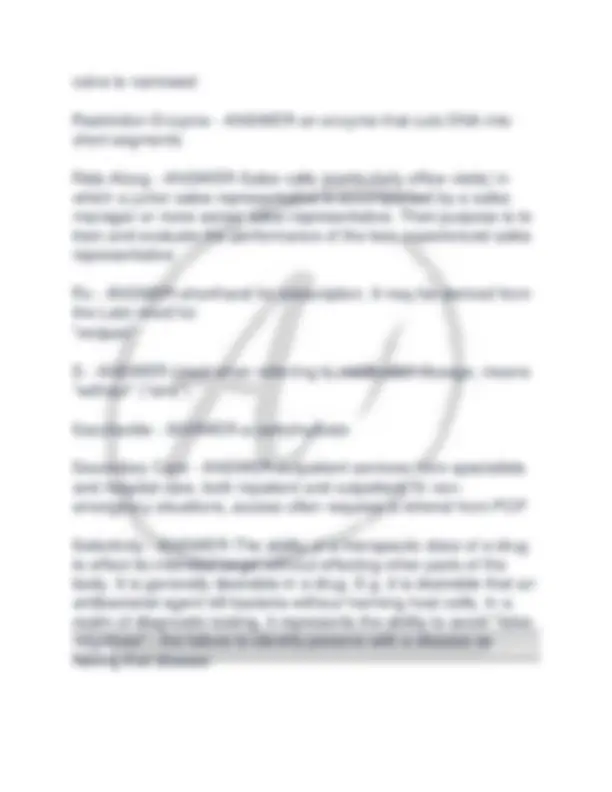
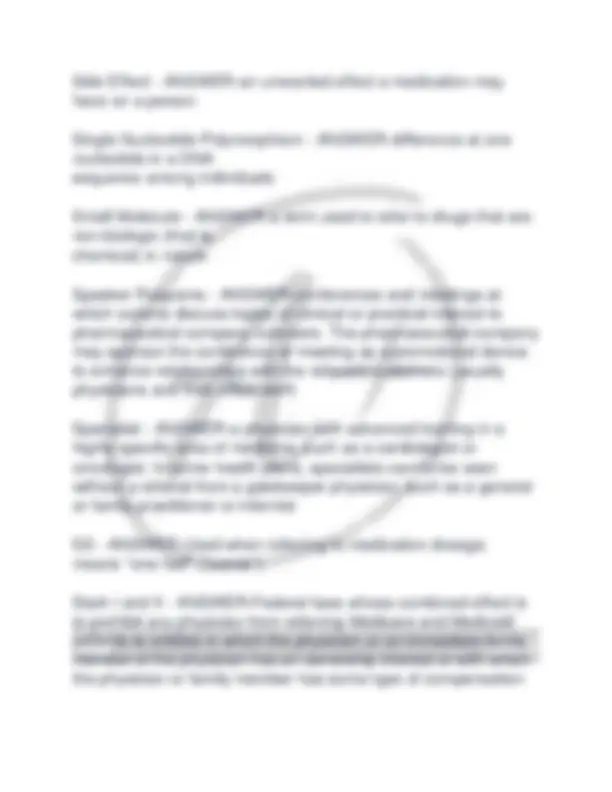


Study with the several resources on Docsity

Earn points by helping other students or get them with a premium plan


Prepare for your exams
Study with the several resources on Docsity

Earn points to download
Earn points by helping other students or get them with a premium plan
Community
Ask the community for help and clear up your study doubts
Discover the best universities in your country according to Docsity users
Free resources
Download our free guides on studying techniques, anxiety management strategies, and thesis advice from Docsity tutors
NAPRX/CNPR TEST BANK 2025-2026 QUESTIONS AND CORRECT ANSWERS RATED A+
Typology: Exams
1 / 121

This page cannot be seen from the preview
Don't miss anything!





























































































Office of inspector General (OIG) - ANSWER-an arm of the department of Health and Human Services, which investigates regulatory infractions, provides compliance advice, and brings enforcement actions Federal Trade Commission (FTC) - ANSWER-Regulates general business practices to protect consumers against anti-competitive behavior and misleading claims Drug Enforcement Administration (DEA) - ANSWER-Regulates the distribution and use of narcotics and other controlled substances Antibodies - ANSWER-are proteins made by the body's immune system to bind and to neutralize foreign invaders.
Monoclonal Antibodies - ANSWER-antibodies used against breast cancer and nonHodkin's lymphoma, are created in laboratories to target the immune system of patients to specifically kill cancer cells Passive Diffusion - ANSWER-Diffusion is the random movement of molecules in fluid. Because of the lipid bilayer construction of the membrane, non-polar (lipid soluble) molecules are able to diffuse and penetrate the cell membrane. Polar molecules, however, cannot penetrate cell membrane readily via passive diffusion and rely on other transport mechanisms. Facilitated Diffusion - ANSWER-Polar drug molecules have been observed to cross cell membranes. The transport mechanism is via carrier systems. Transmembrane carriers, such as proteins, are similar to receptors and bind polar and non-polar drug molecules. They facilitate the diffusion of drugs across the cell membrane. This diffusion is from a region of high concentration to low concentration. Active Transport - ANSWER-the mechanism requires energy to drive the transportation of drugs against the concentration gradients, from low to high. The transportation rate is dependent on the availability of carriers and energy supply via a number of biologica l pathways. Pinocytosis - ANSWER-involves the engulfing of fluids by a cell. The process commences with the infolding of cell membrane around fluids containing the drug. The membrane then fuses and
more polar molecules, which are less lipid-soluble and are excreted from the body Expression of Clearance of a Drug - ANSWER-CL = Rate of drug elimination/Drug concentration in the blood Single dose - ANSWER-This type of toxicity testing is conducted for several purposed, including the determination of repeated doses, identification of organ is subjected to toxicity, and provision of data for starting doses in human clinical trials. Various characteristic of the animals are monitored, including weights, clinical signs, organ functions, biochemical parameters, and mortality. At the completion of the study, animals are killed and autopsies are preformed to analyze the organs, especially the targeted organ for the drug Repeated Dose - ANSWER-In this type of toxicity study the aim is to evaluate the longer-term effects of the drug in animals. Plasma drug concentrations are measured and pharmacokinetics analyses are performed. Vital functions studied include cardiovascular, respiratory and nervous systems. Animals are retained at the end of the study to check toxicity recovery Carcinogenicity - ANSWER-type of study that is carried out to identify the tumor-causing potential of a drug. Reproductive toxicology - ANSWER-The aim of these studies is to assess the effect of the potential drug on mammalian reproduction
MRSD - ANSWER-maximum recommended starting dose NOAEL - ANSWER-no observed adverse effect level HED - ANSWER-human equivalent dose Drug sample - ANSWER-is a unit of drug which is not intended to be sold and is intended to promote the sale of the drug product Sampling - ANSWER-may be the single most important factor in a pharmaceutical rep's success Section 503 of the Federal Food, Drug and Cosmetic Act - ANSWER-this prohibits the sale, purchase, offer to sell, purchase, or trade prescription drug samples and drug coupons. 3 Methods of E-Sampling - ANSWER-1. physicians can order samples online, and samples are delivered by mail to each physician's practice
Pharmaceuticals - ANSWER-Medicines and vaccines for human and animal use; products may have a trademark (brand) name or be generic, and they may be prescription or over-the counter Diagnostic - ANSWER-Equipment and supplies used in screening, detecting, and monitoring disease, can range from simple home testing kits to sophisticated diagnostic imaging technologies Medical Devices - ANSWER-Advanced instrumentation and appliances used for medical therapy, such as joint replacements, implantable defibrillators, and pacemakers; also, drug delivery devices such as syringes, infusion pumps, metereddose inhalers, and transdermal patches Medical Supplies - ANSWER-Commodity, high-volume supplies used such as surgical gowns and gloves Durable Medical Equipment - ANSWER-Reusable products for health-related use in the home, such as walkers, wheelchairs, oxygen equipment, prosthetics and hospital beds Medical Library - ANSWER-One of the oldest methods of acquiring medical information, most hospitals or clinics will have a library where current information will be available Medical Journals - ANSWER-These are considered good sources of information. They
provide current perspectives from leading experts on various disease states and treatment options. Major and current studies will be published in the more reputable ones Specialists - ANSWER-They are usually involved in medical research. You will mos t often find them at universities or medical schools but they may also be found in private practice. They perform the testing and do the necessary research for new products. Approvable letter - ANSWER-Letter's sent by the FDA to the applicant indicating whether the application (NDA) or abbreviated application (ANDA) for a product substantially meets the necessary requirements and whether or not the agency believes that it can approve the application or abbreviated application if specific additional information or material is submitted or specific conditions (for example, certain changes in labeling) are agreed to by the applicant Fast- Track Drugs - ANSWER-Approval is provided for drugs that meet medical needs for patients with serious or life-threatening conditions. Placebo - ANSWER-is an inactive pill, liquid or powder that has no treatment value. In clinical trials, experimental treatments are often compared with this to assess the treatments effectiveness
Indication - ANSWER-In terms of drug approval, the exact cause or purpose for whether a drug is approved by the FDA to be prescribed Institutional Review Board - ANSWER-A committee of physicians, statisticians, community advocates, and others, which ensures that a clinical trial is ethical and that the rights of the study participants are protected. All clinical trials in the U.S. must be approved by this committee before they begin Study Protocol - ANSWER-The general design and operating features of a trial. It is distinguished from the study manual of operations by its generality and absence of specific details needed for day-to-day execution of the trial. Toxicity - ANSWER-The extent, quality, or degree to which a substance is poisonous or harmful to the body Treatment Group - ANSWER-A group of patients assigned to receive a specified treatment Off Label - ANSWER-Usage of a medication for purposes other than the specific ones appearing in the labeling Off Label - ANSWER-Usage of a medication for purposes other than the specific ones appearing in the labeling Anatomy - ANSWER-the study of the basic structure of the body
Physiology - ANSWER-the study of how those body structures function Clinical Pharmacology - ANSWER-the study of the effects and movement of drugs in the human body Drug - ANSWER-defined by the United States law as any substance (other than a food) or device intended for us in the diagnosis, cure, relief, treatment, or prevention of disease intended to affect the structure or function of the body Drug Abuse - ANSWER-the excessive and persistent use of mind-altering substances without medical need Preclinical testing - ANSWER-testing that gathers information about how the drug works, how effectively it works, and what toxic effects it produces, including possible effects on reproductive capacity and the health of offspring. Margin of safety - ANSWER-The difference between the usual effective dose and the dose that induces severe or life-threatening side effects Drug administration - ANSWER-the giving of a drug by one of several means (routes)
Sublingual Route - ANSWER-route where drugs are places under the tongue so that they can be absorbed directly into the small blood vessels that lie beneath the tongue. Rectal Route - ANSWER-route where a drug is administered rectally as a suppository Vaginal Route - ANSWER-route where drug is administered vaginally to women as a solution, tablet, cream, gel, or suppository Ocular Route - ANSWER-route where a drug can be mixed with inactive substances to make a liquid, gel, or ointment, so that they can be applied to the eye Nasal Route - ANSWER-route where a drug is to be breathed through the thin mucous membrane that lines the nasal passages, it must be transformed into tiny droplets in air (atomized) Cutaneous Route - ANSWER-route where drugs applied to the skin are usually used for their local effects and thus are most commonly used to treat superficial skin disorders. Depending on the consistency of the inactive substances, the formulation may be an ointment, a cream, a lotion, a solution, a powder, or a gel. Transdermal Route - ANSWER-route where drugs are delivered body wide though a patch on the skin
Wasting the medication - ANSWER-disposal of controlled medications by flushing it into the sewer line. For controlled substances, you must ask someone to witness and document the disposal Medication error - ANSWER-the inappropriate or incorrect administration of a drug that should be preventable though effective system controls involving physicians, pharmacists, nurses, risk-management personnel, legal counsel, administrators, and patients Drug absorption - ANSWER-is the movement of a drug into the bloodstream Modified release - ANSWER-drug products that are specially formulated to release their active ingredients slowly or in repeated small amounts over time usually for a period of 12 hours or more. Also known as: controlled-release, sustained release, or extended release Drug distribution - ANSWER-the movement of drug to and from the blood and various tissues of the body (for example: fat, muscle, and brain tissue) and the relative proportions of drug in the tissues Drug metabolism - ANSWER-the chemical alteration of a drug by the body
different rates; therefore, the drug is released into the digestive system gradually. Enteric coating - ANSWER-coating on some tablets and capsules that keeps them from dissolving in the stomach, which contains hydrochloric acid. These drugs don't dissolve until they reach the intestine. Caplet - ANSWER-is shaped like a capsule but has the form of a tablet. The shape and film coating make swallowing easier Gel Cap - ANSWER-an oil-based medication that is enclosed in a soft gelatin capsule Powders - ANSWER-a drug that is dried and ground into fine particles. Granules - ANSWER-a small pill, usually accompanied by many others encased within a gelatin capsule Troches or Lozenges - ANSWER-a hard or semisolid dosage form containing a medication intended for local application in the mouth or throat. Liquid Drugs - ANSWER-liquid preparations include drugs that have been dissolved or suspended
Syrups - ANSWER-aqueous solutions containing high concentration of sugars, syrups, and linctuses which may or may not have medicinal substances added Solutions - ANSWER-a drug or drugs dissolved in an appropriate solvent. Ex. Elixirs, fluid extracts, spirits, and tinctures Elixirs - ANSWER-a drug vehicle that consists of water, alcohol and sugar Fluid Extracts - ANSWER-a concentrated solution of a drug removed from a plant source by mixing ground parts of the plant with a suitable solvent, usually alcohol, and then separating the plant residue from the solvents Mixtures and Suspensions - ANSWER-an agent is mixed with a liquid but not dissolved. These preparations must be shaken before being taken or administered to the patient Tinctures - ANSWER-an alcoholic preparation of a soluble drug, usually from a plant source. Emulsions - ANSWER-a pharmaceutical preparation in which two agents that cannot ordinarily be combined or mixed Spirits or Essences - ANSWER-an alcohol-containing liquid that may be used
Pharmacogenetics - ANSWER-the study of genetic differences in the response to drugs Drug-drug Interactions - ANSWER-changes in a drug's effects caused by another drug taken during the same time period Dietary supplement-drug interaction - ANSWER-changes in a drug's effects caused by a dietary supplement taken during the same time period Drug-Food Interactions - ANSWER-changes in a drug's effects caused by food (including beverages) consumed during the same time period. Tolerance - ANSWER-a person's diminished response to a drug, which occurs when the drug is used repeatedly and the body adapts to the continued presence of the drug. Resistance - ANSWER-the ability of microorganisms or "cancel" cells to withstand the effects of a drug usually effective against them Overdose Toxicity - ANSWER-refers to serious, often harmful, and sometimes fatal toxic reactions to an accidental overdose of a drug (because of a doctor's, pharmacist's, or patient's error) or to an intentional overdose (homicide or suicide). Compliance - ANSWER-the degree to which a person take prescribed drugs as directed
Mechanism of Action - ANSWER-the way in which an API works in the body The Active Pharmaceutical Ingredient (API) - ANSWER-the ingredient in drugs that is intended to produce the desired change in the body Pharmacodynamics - ANSWER-assesses the biochemical effects of the drug on the body at various doses, or more specifically, the drug's actions and effects at a molecular level Cell Membrane - ANSWER-all cells are wrapped in a semi- permeable membrane tha t protects them from outside elements and distinguished them from their surroundings. Also is a barrier that selectively facilitates or blocks entry and exit of various substances into and out of the cell such as drugs, nutrients, and waste. Water usually flows freely Nucleus - ANSWER-the brain of the cell that regulates all activities. Some cells do not have one Cytoplasm/Protoplasm - ANSWER-the substance inside the outer membrane and outside of the nucleus. This contains most of the intracellular fluid Extracellular Fluid - ANSWER-body fluid located between or outside cells. Consists of interstitial fluid or fluid between cells and intravascular fluid or fluid within the blood such as plasma